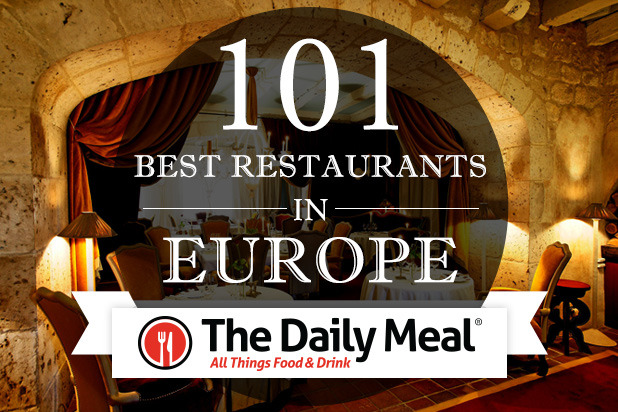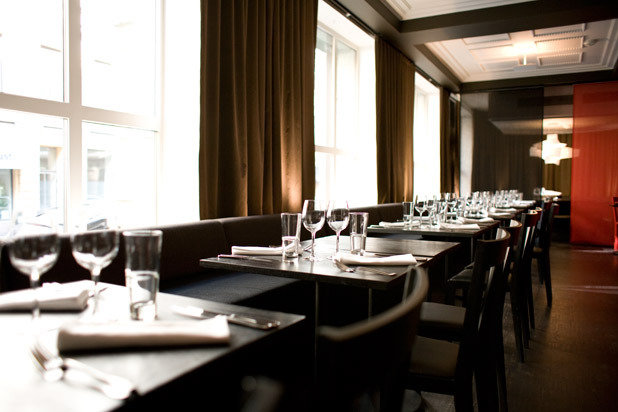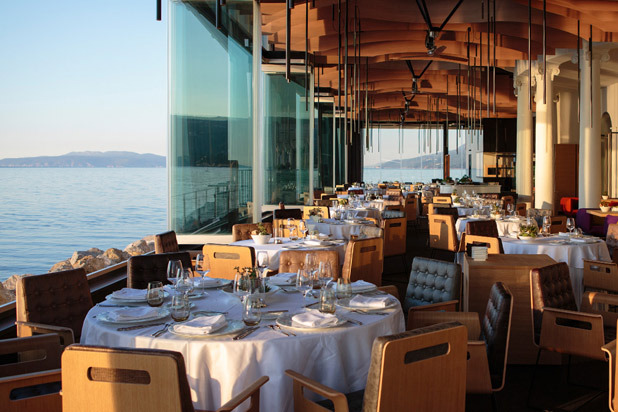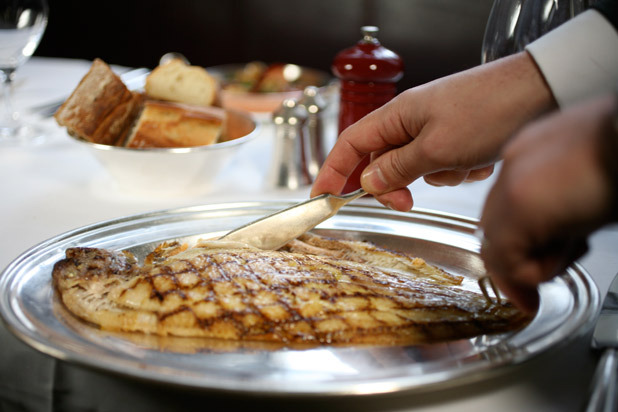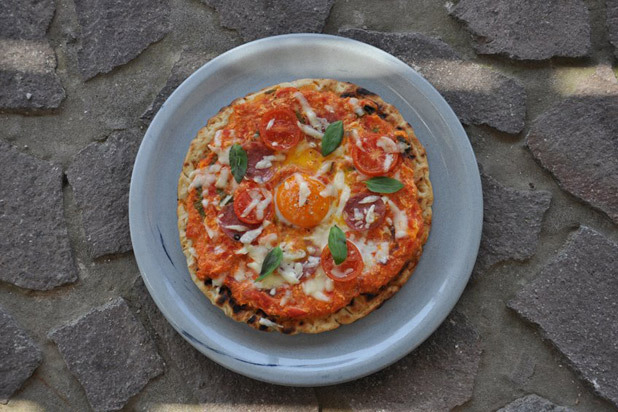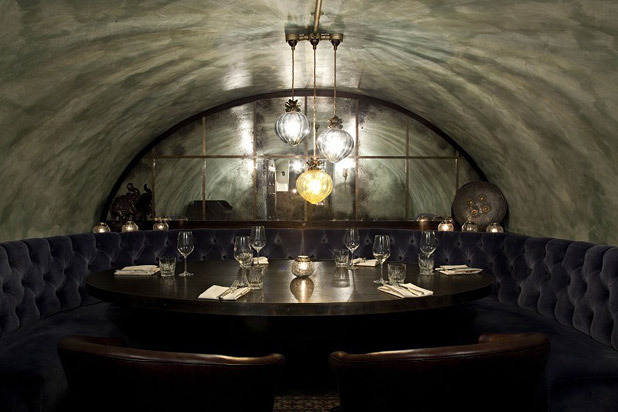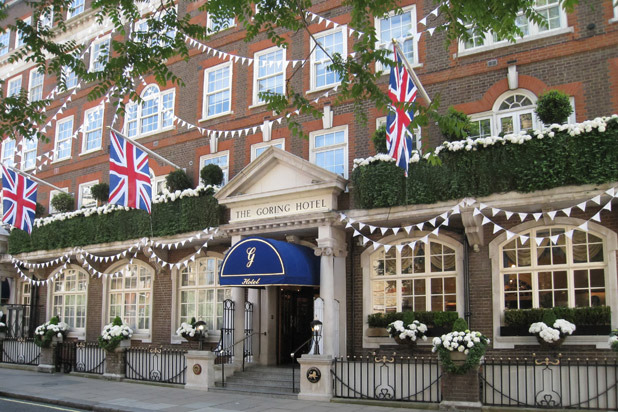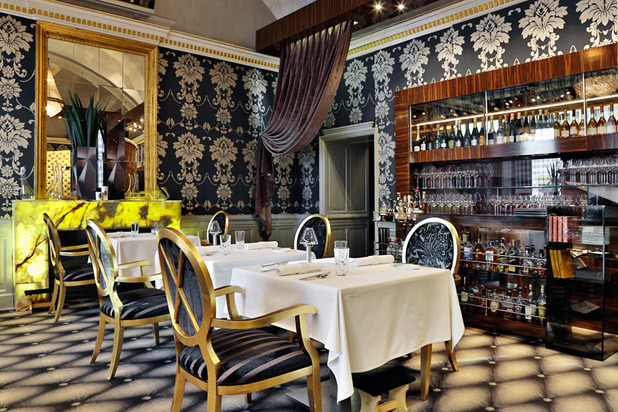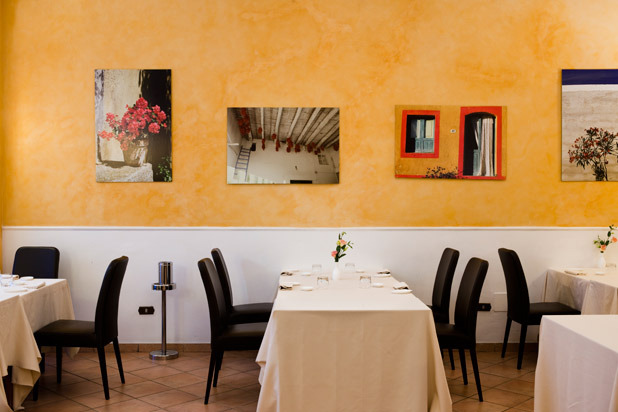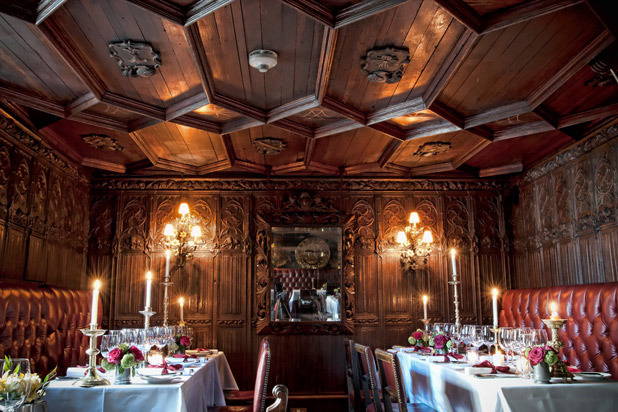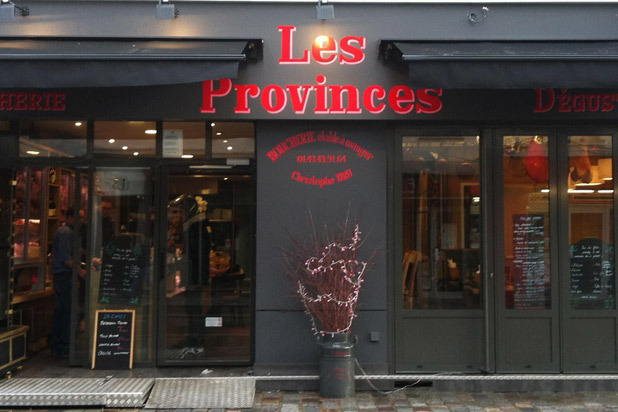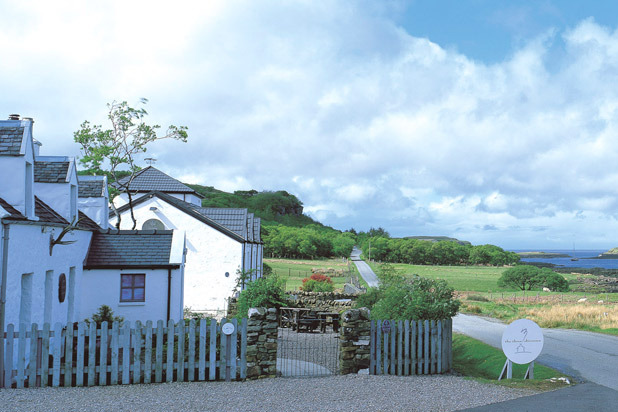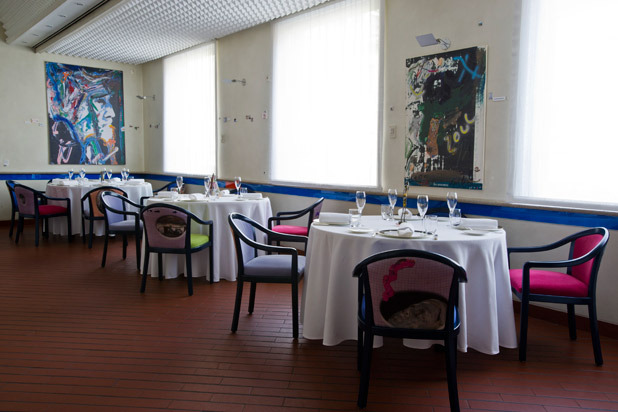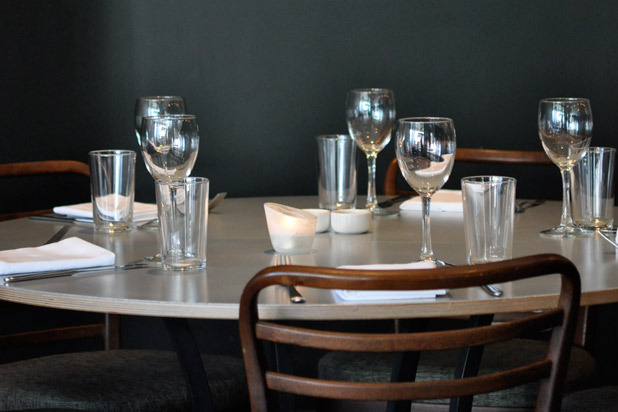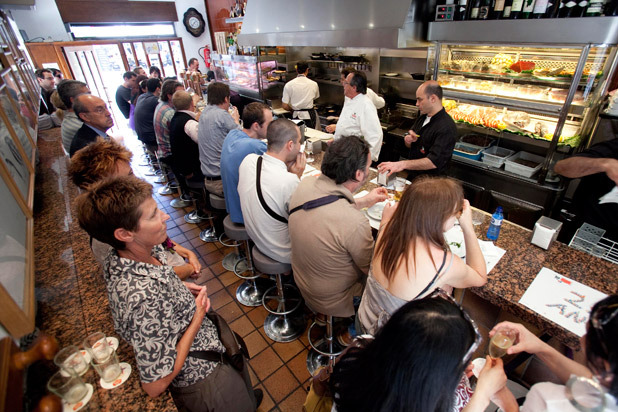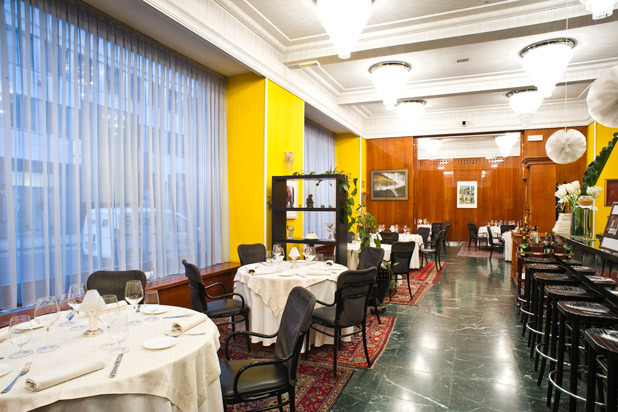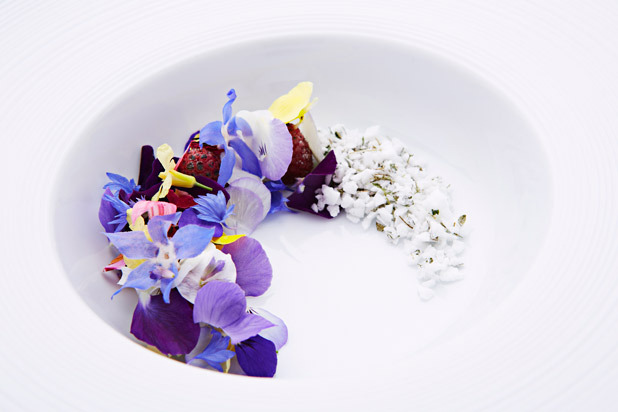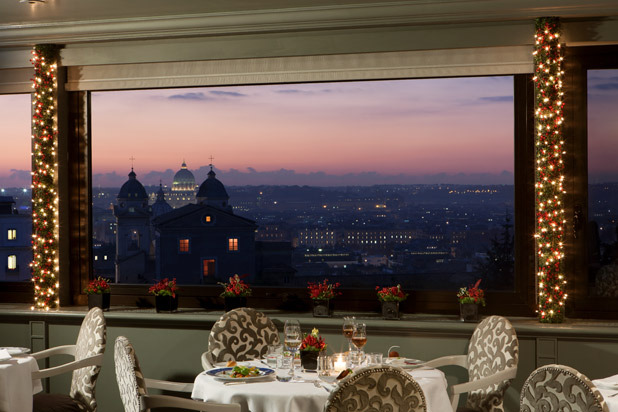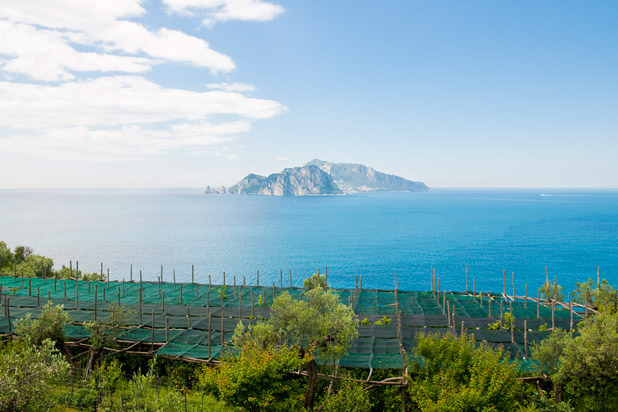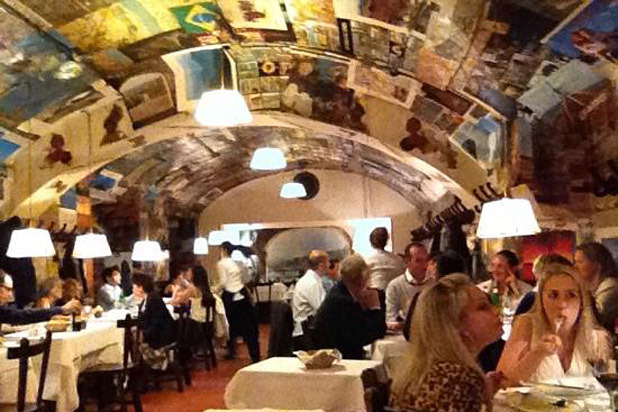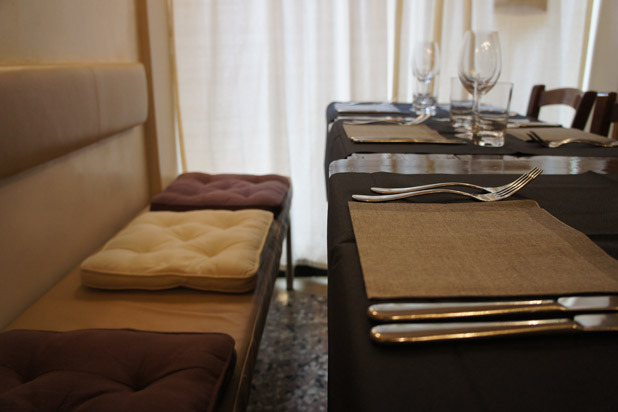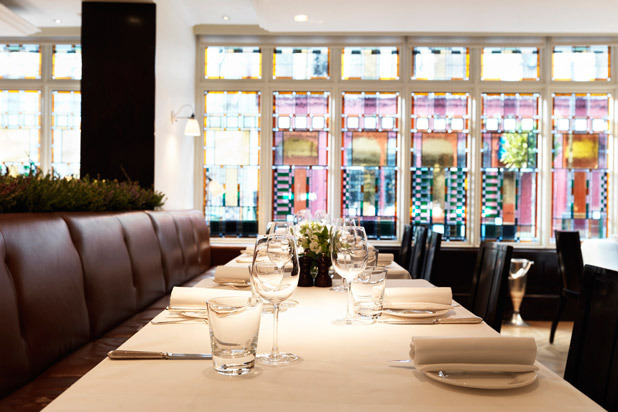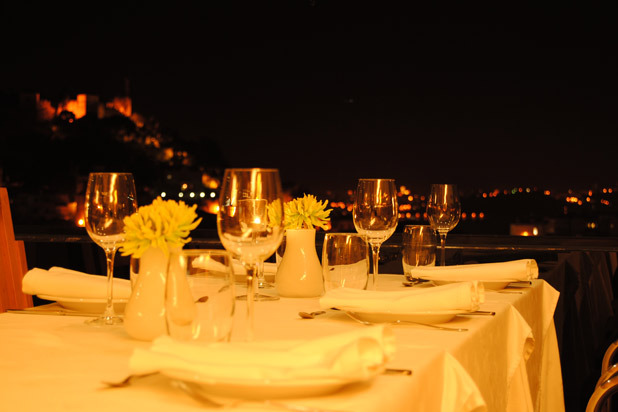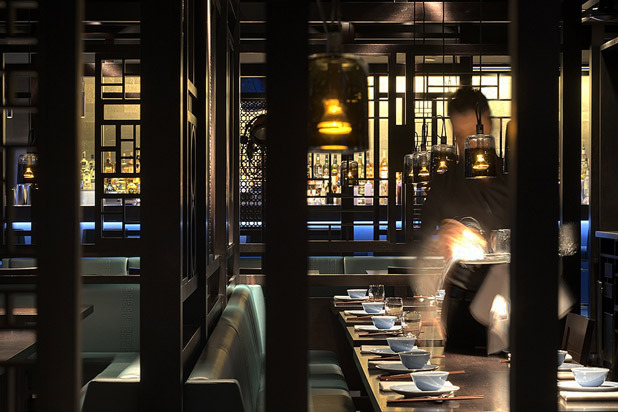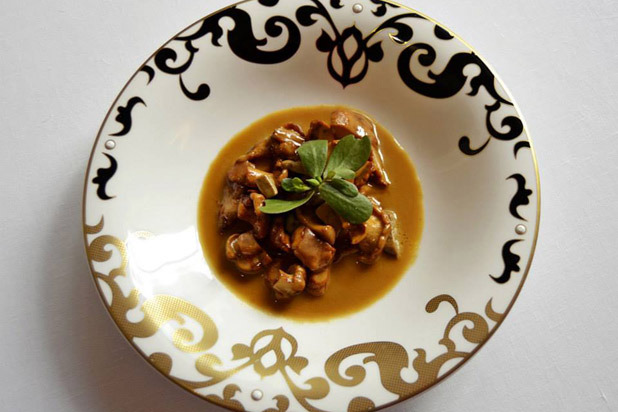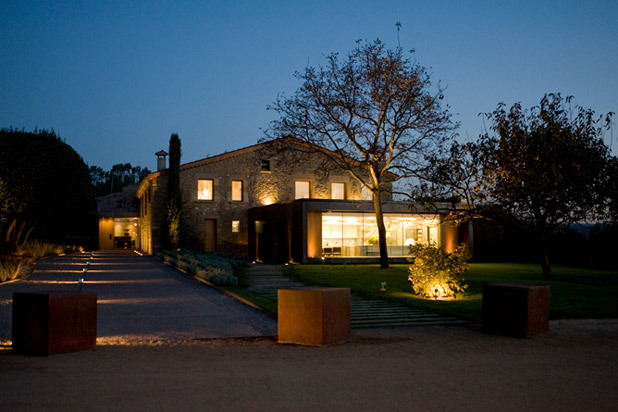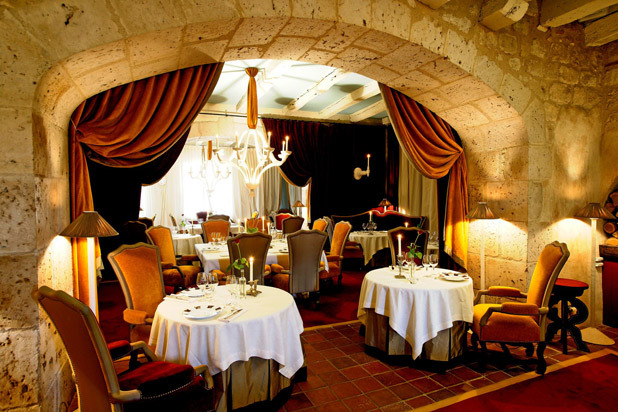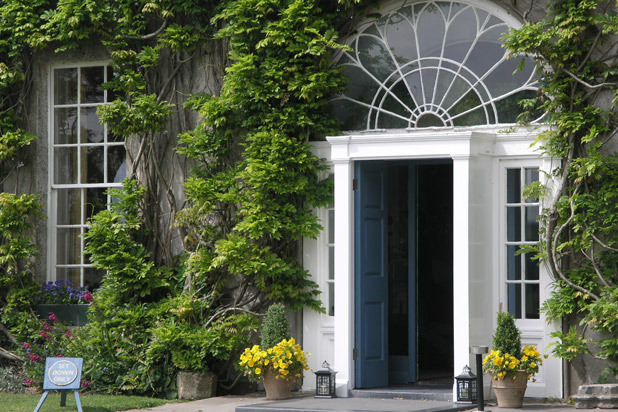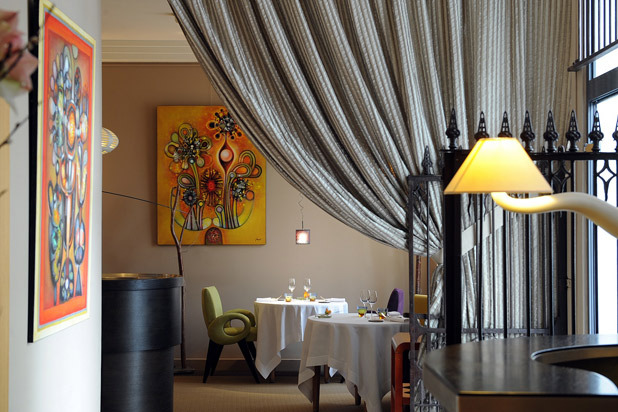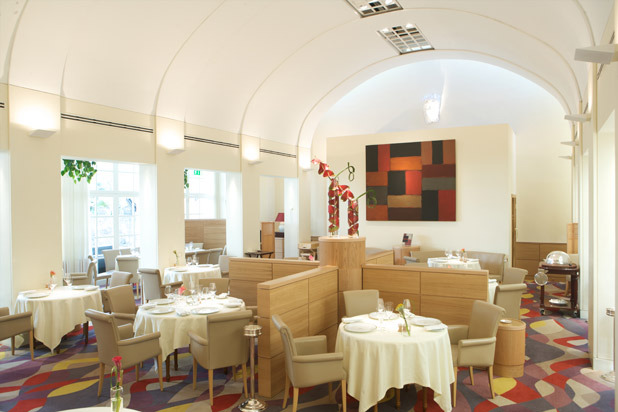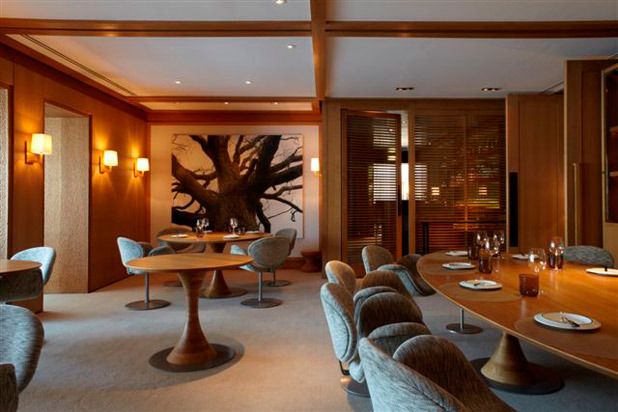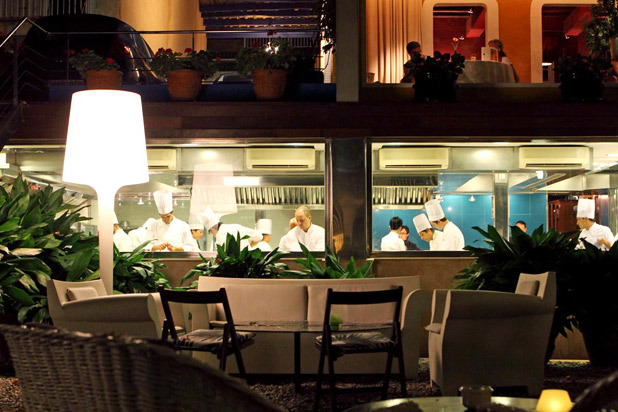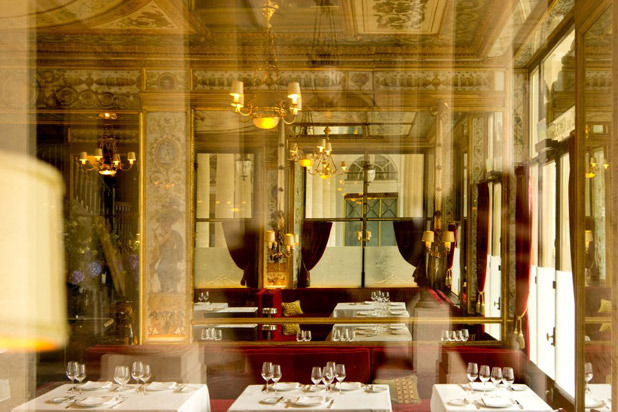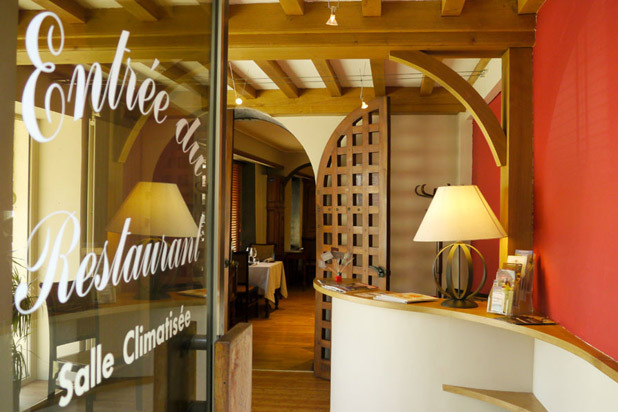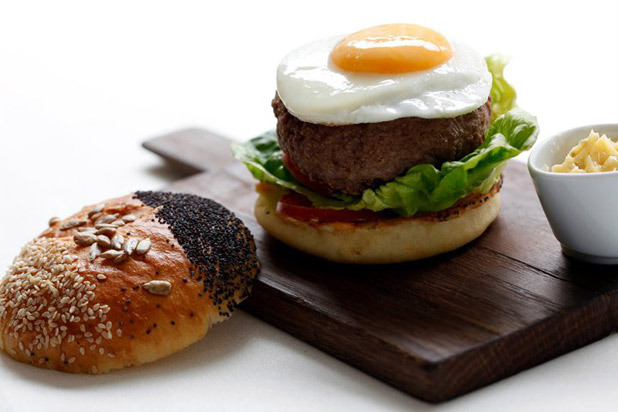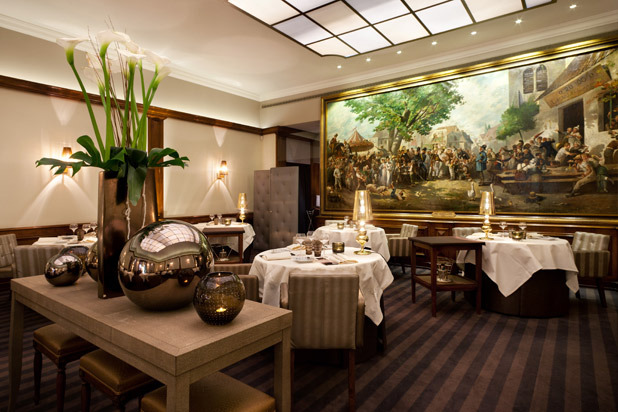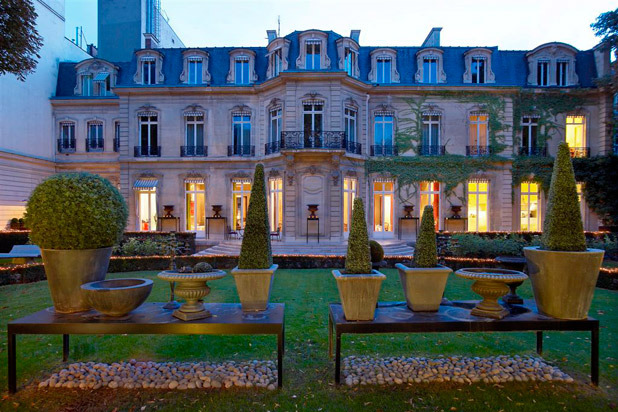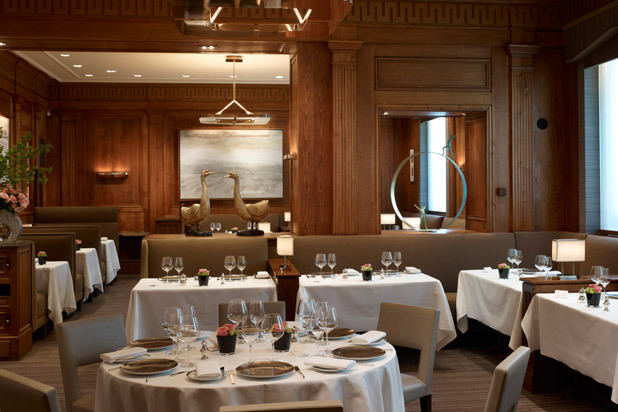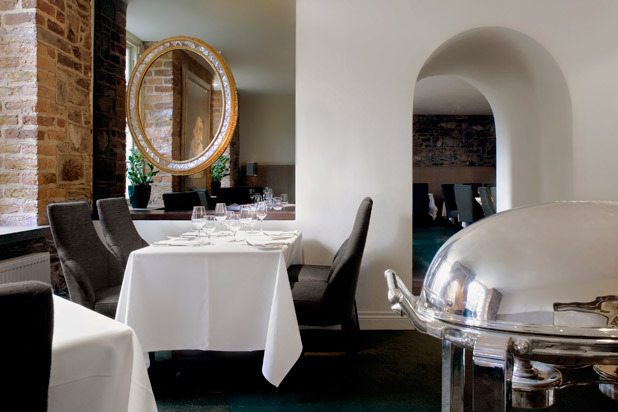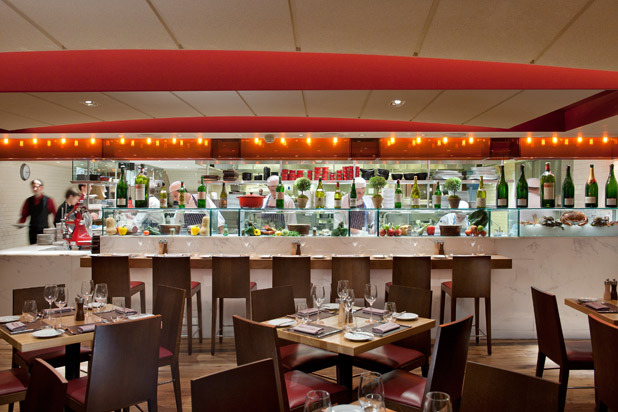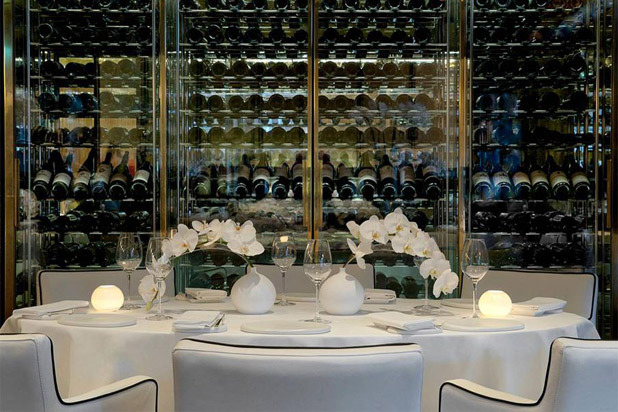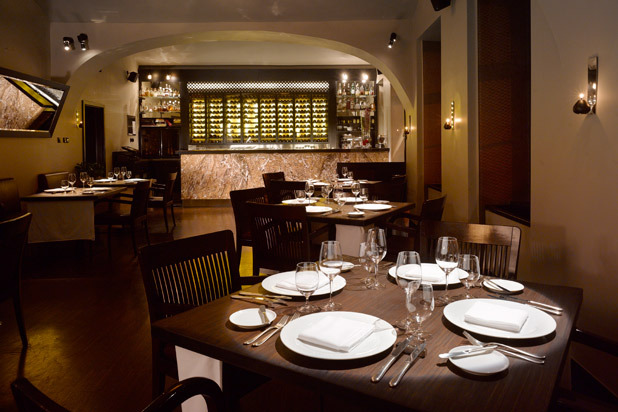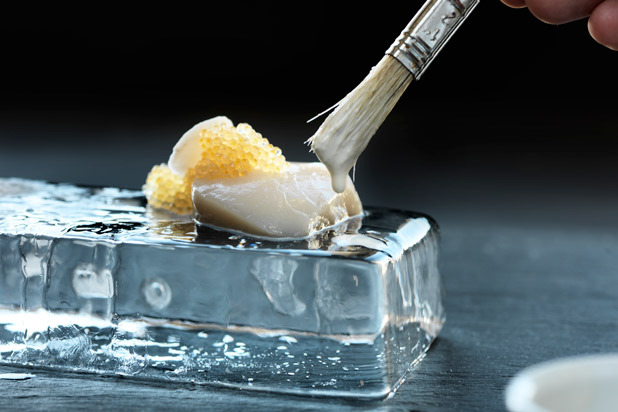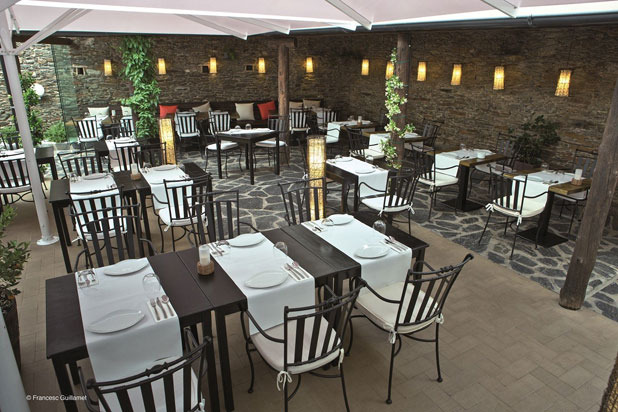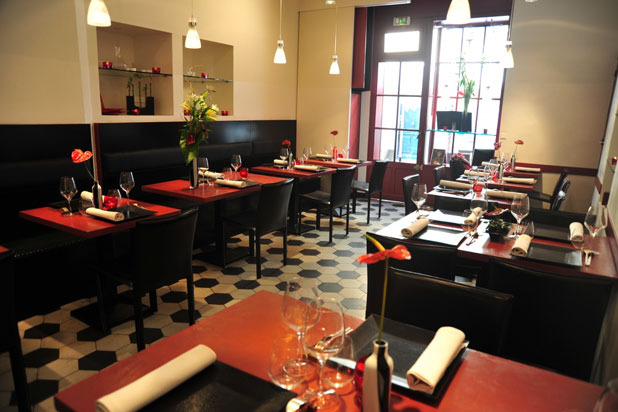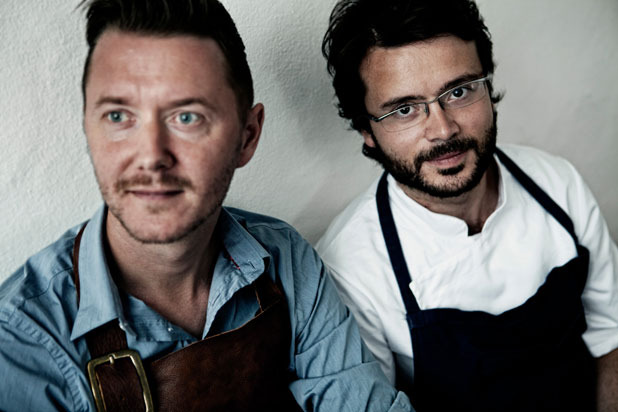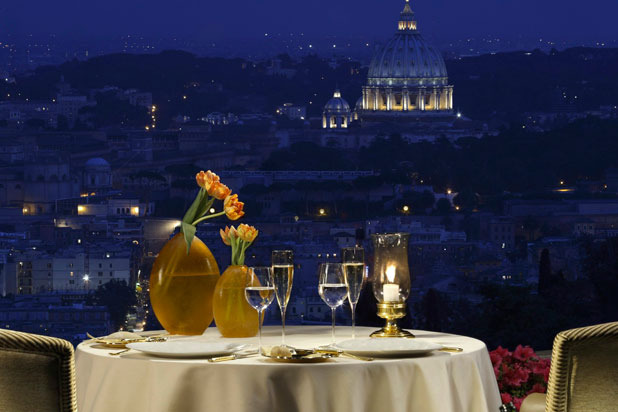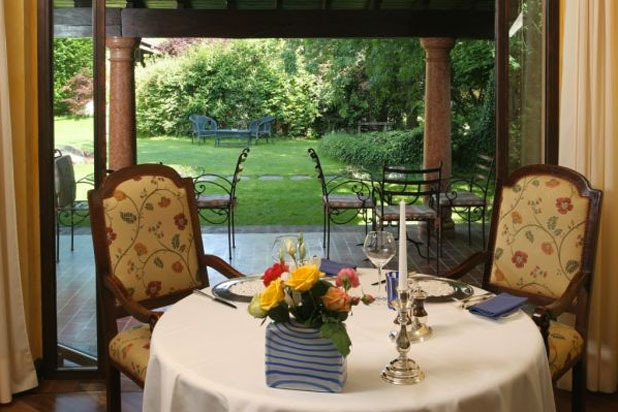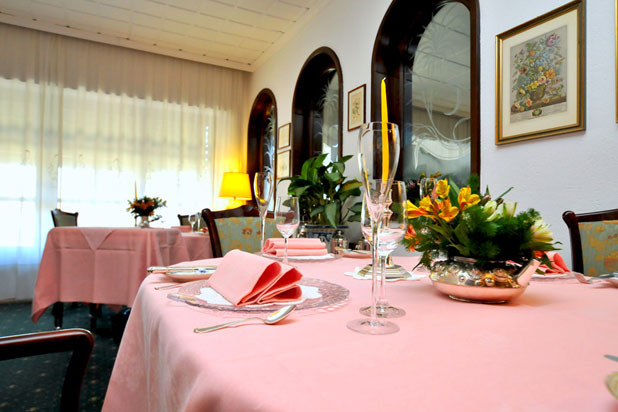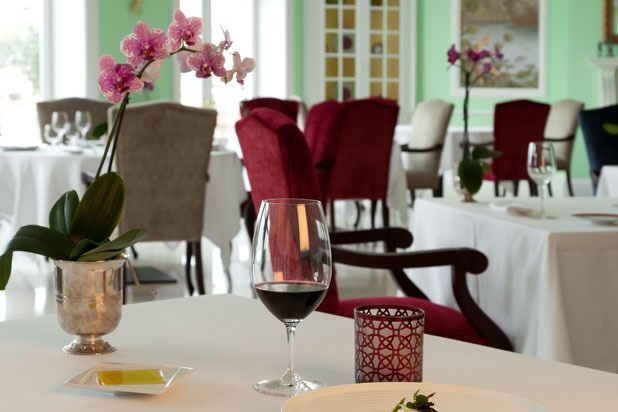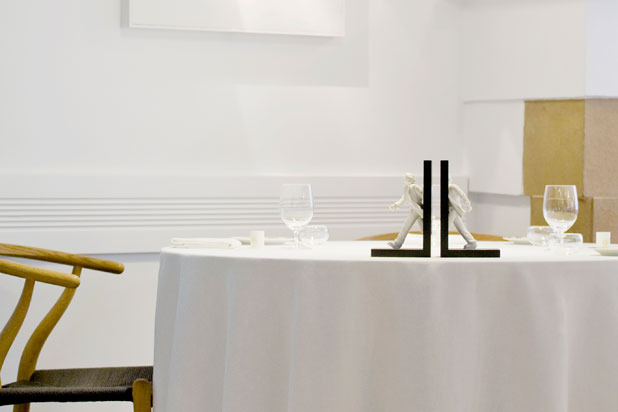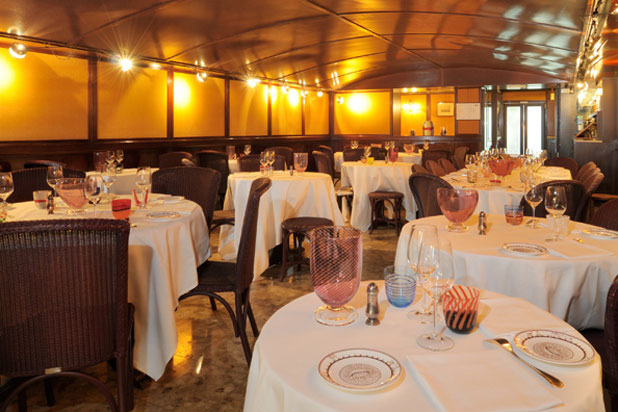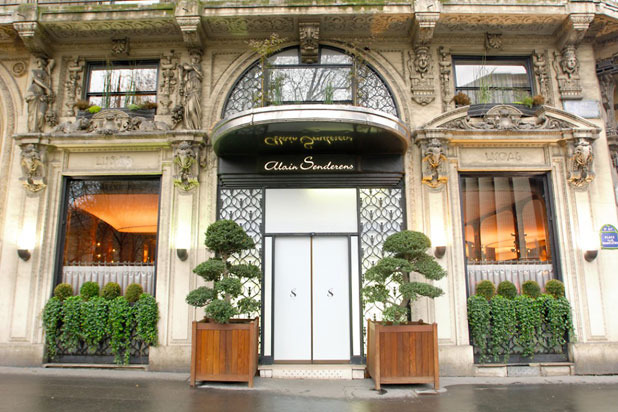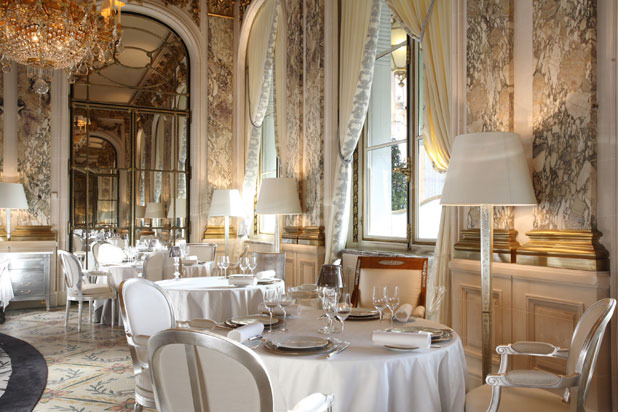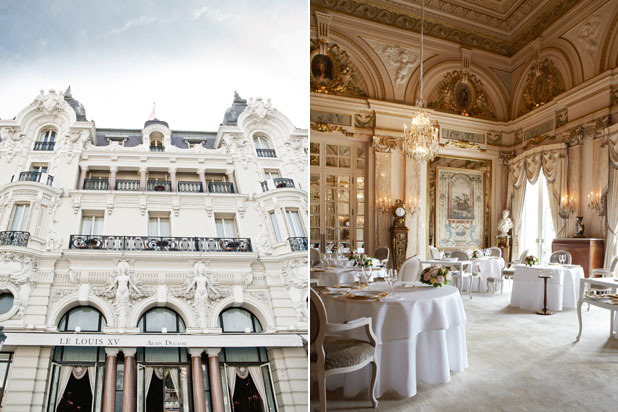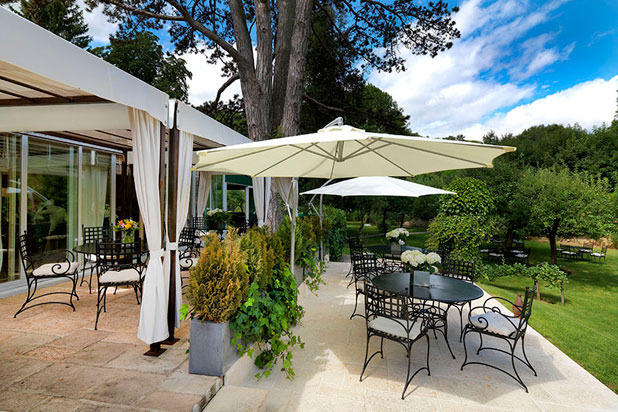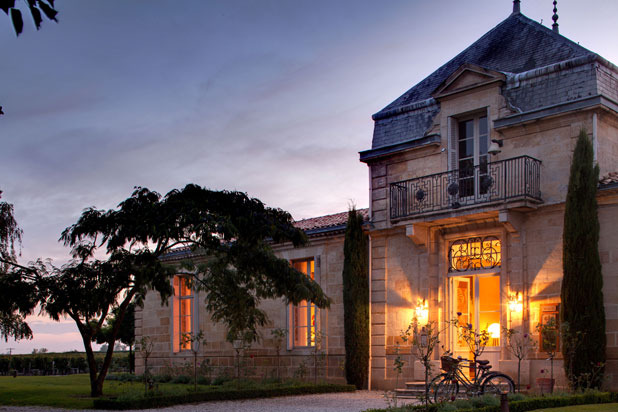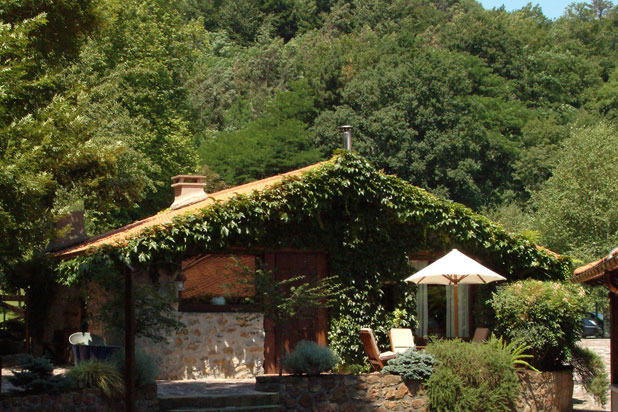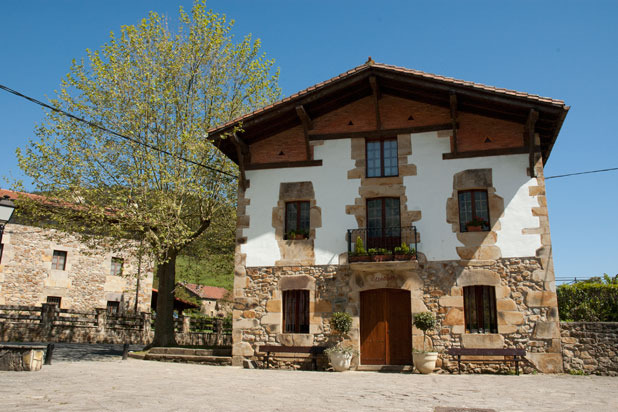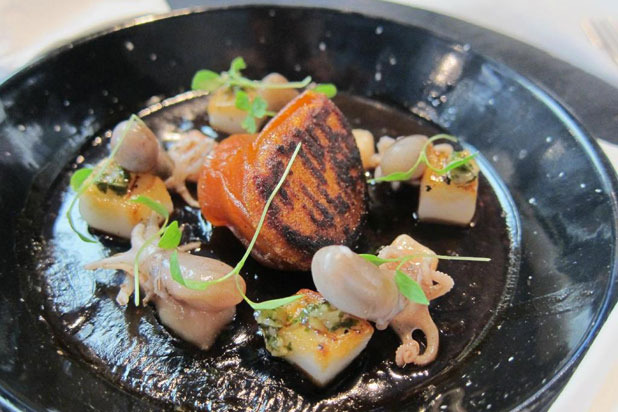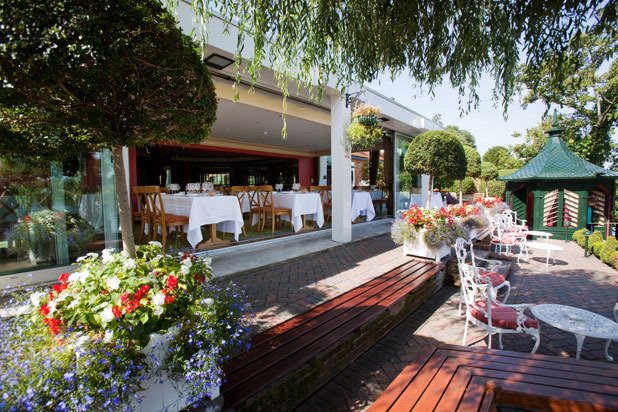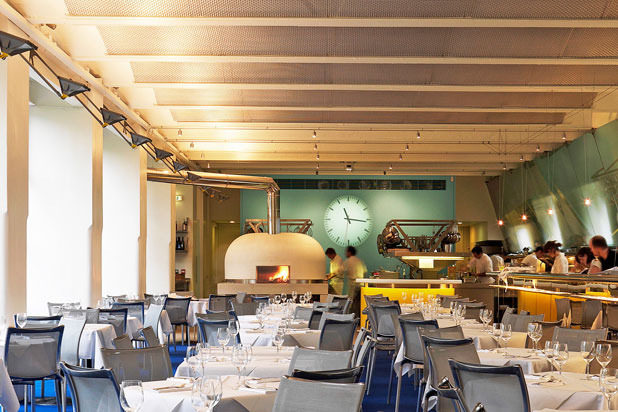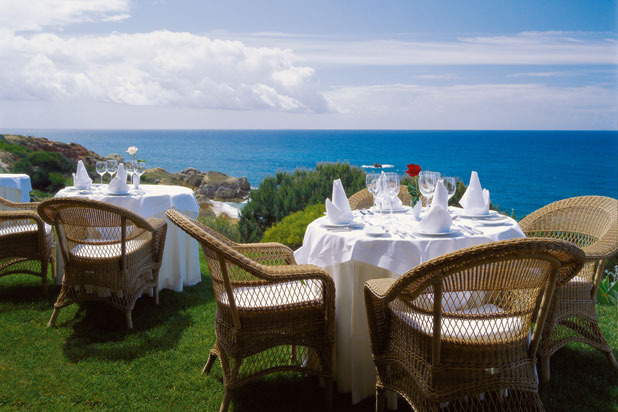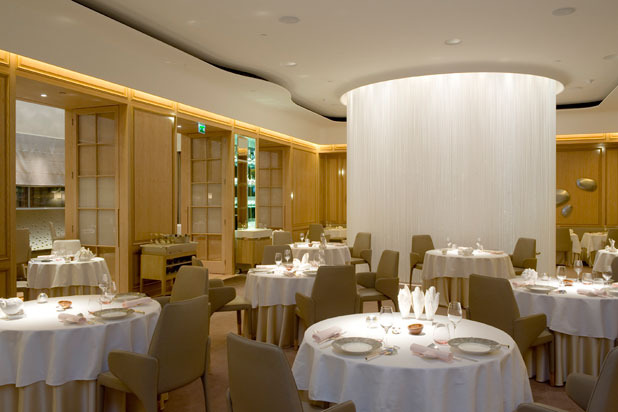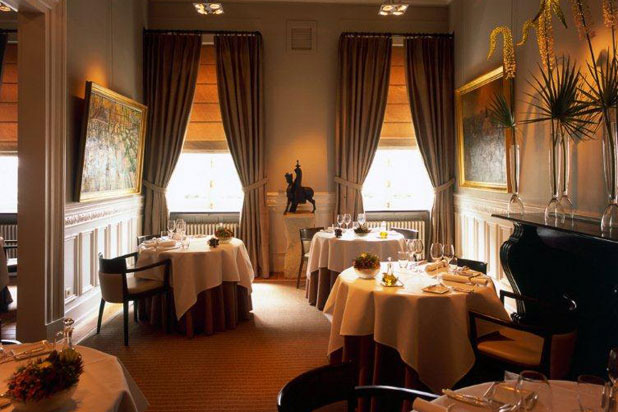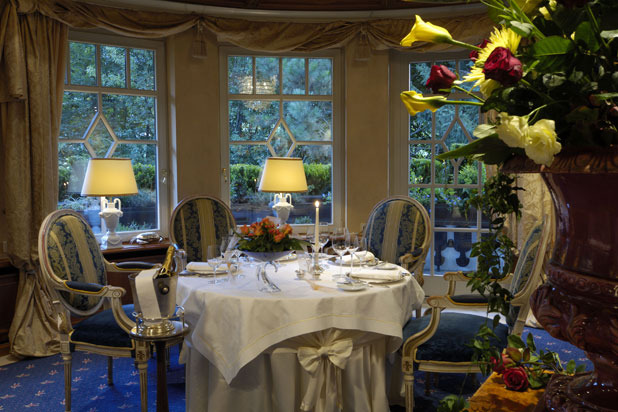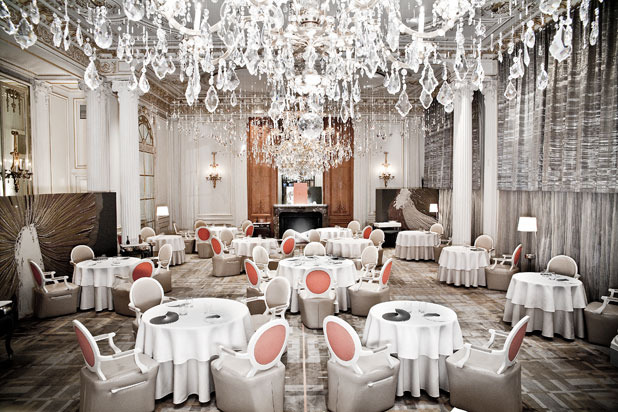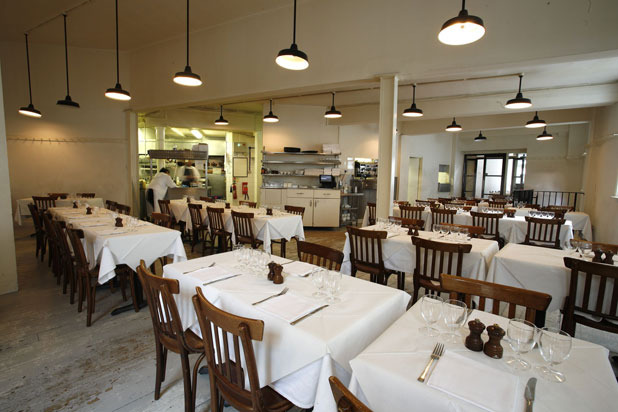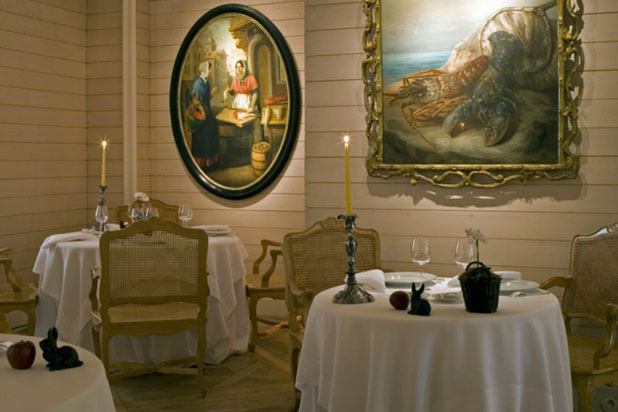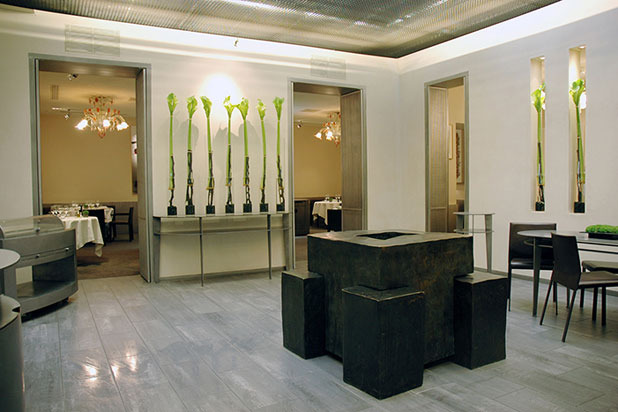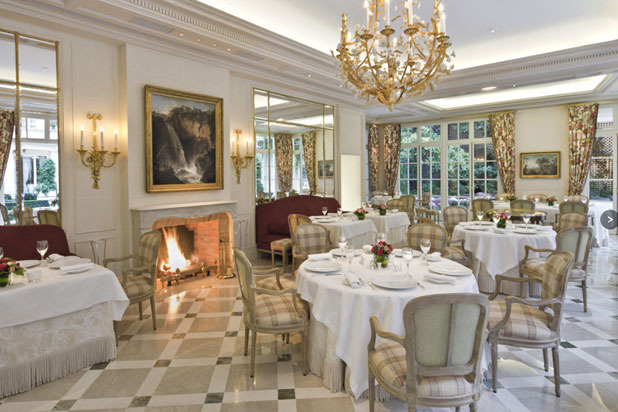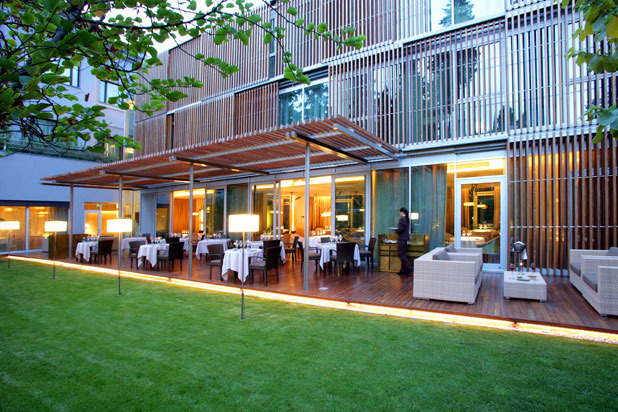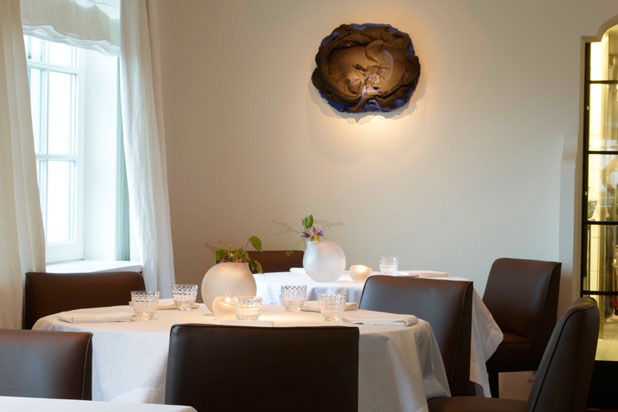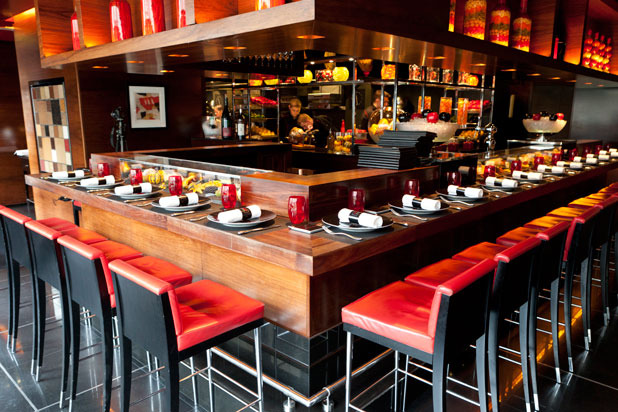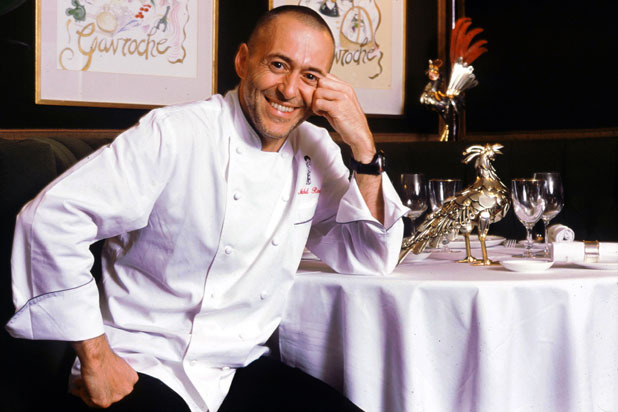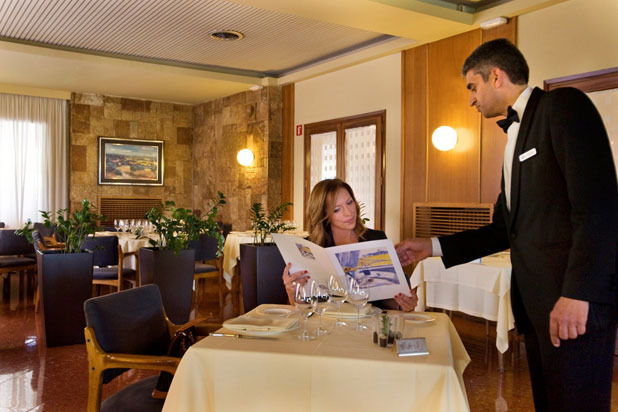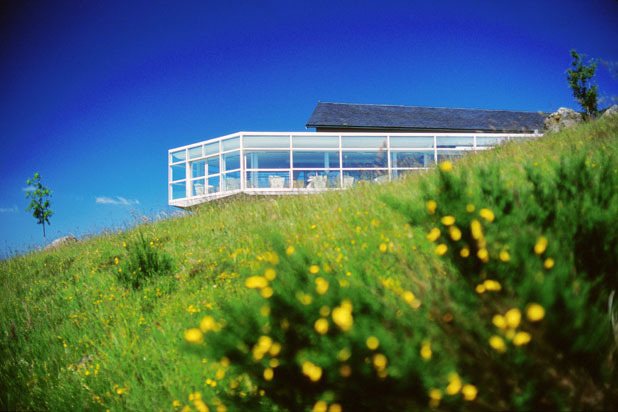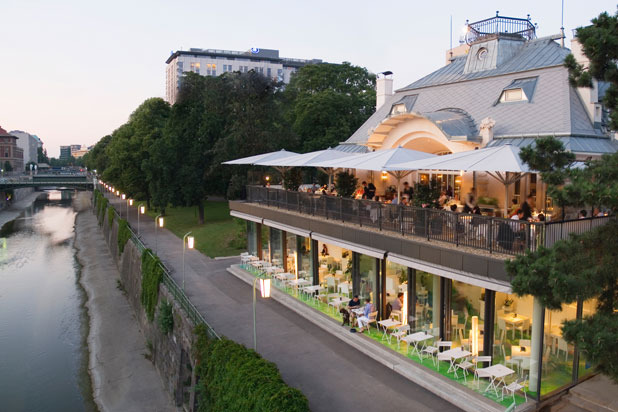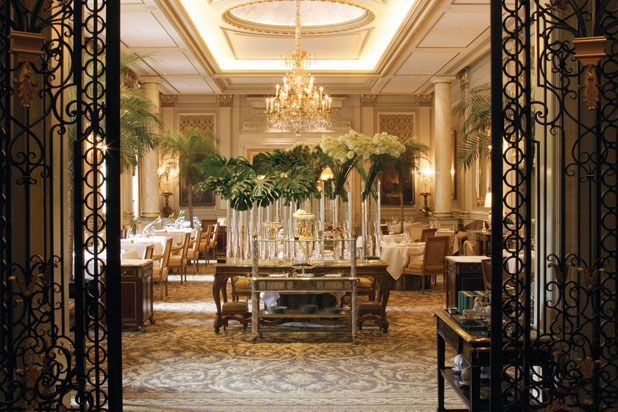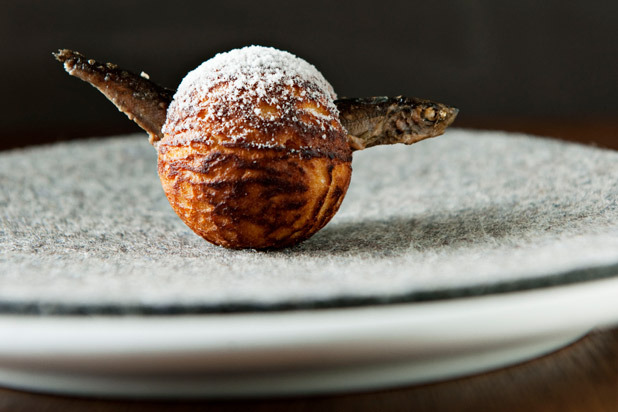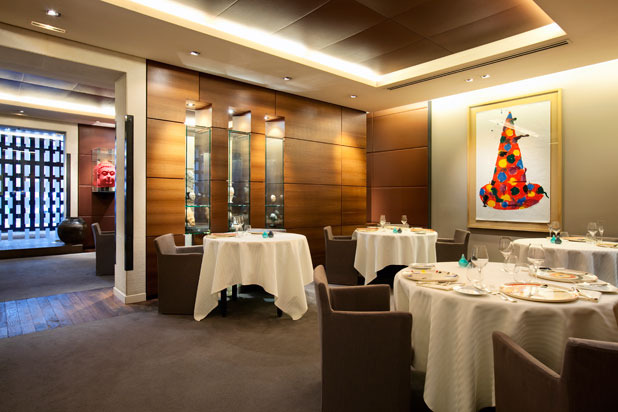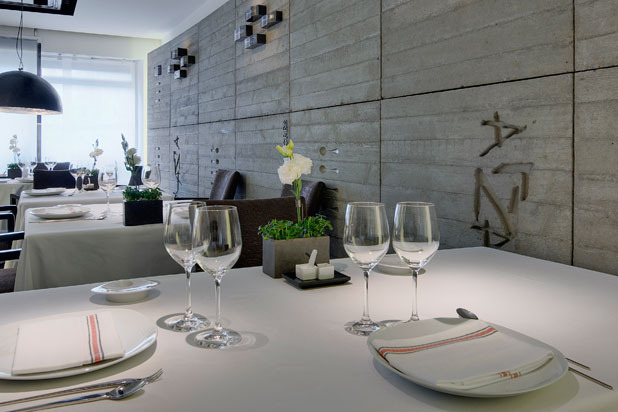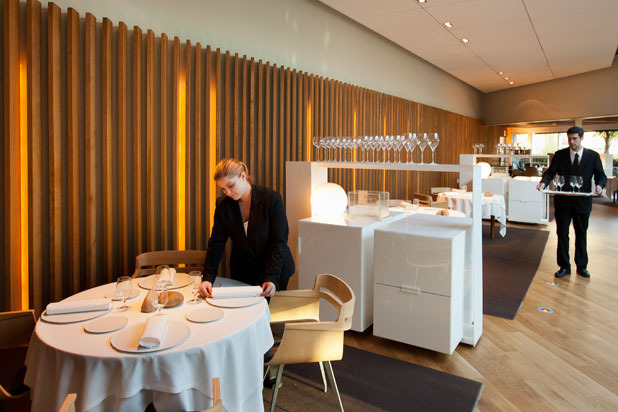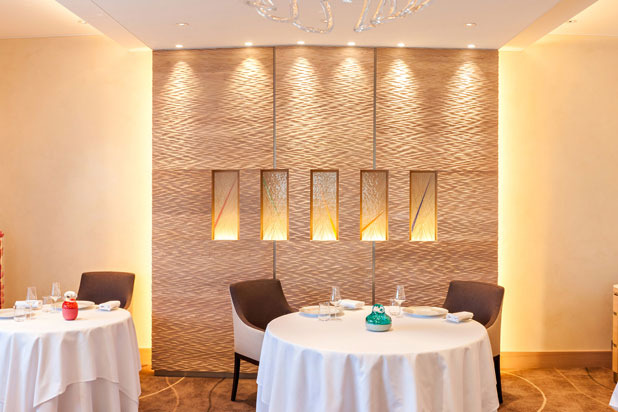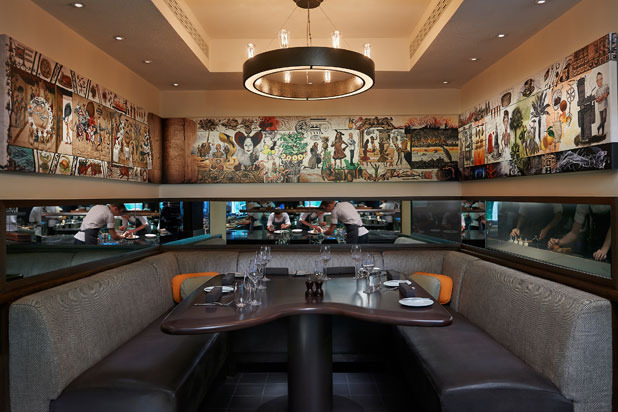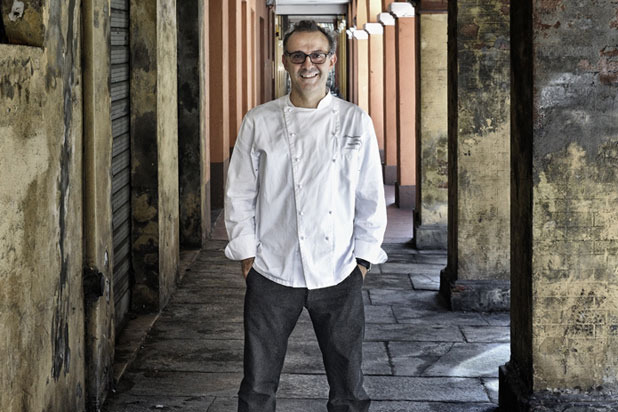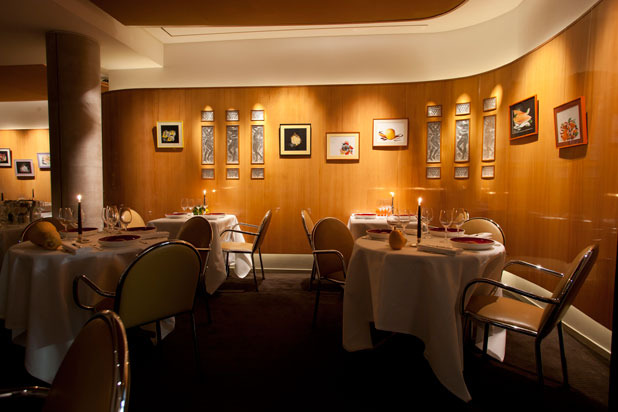101 Best Restaurants In Europe 2014 (Slideshow)
What part of the world has a higher concentration of truly magnificent restaurants than Europe? From cutting-edge Spanish gastronomy to rustic fare from the French and English countryside, from stunning Italian pastas to modern Nordic envelope-pushing cuisine, we're presenting our third annual ranking of the 101 best restaurants in Europe.
#101 Grotesk (Helsinki, Finland)
This Finnish hotspot is known as one of the best bars — for both wine and cocktails — in town, but while "small plates" are the house specialty, the fare is far more than bar food. Chicken and foie gras croquettes, pan-seared scallops with dill and fennel salad, and smoked arctic char with creamed chanterelles are typical of the menu, and the dry-aged Simmental beef rib is arguably the best hunk of meat in Helsinki.
#100 Restaurant Bevanda (Opatija, Croatia)
The best Croatian cooking draws on influences from its neighbors in Italy as well as its own culinary traditions, and makes full use of the wealth of seafood caught off the Dalmatian coast, along with wild game, wild mushrooms, and first-rate fruits and vegetables from the interior. At this beautifully situated hotel-restaurant in the old Adriatic resort town of Opatija, chef Andrej Barbieri offers diners the likes of Kvarner Bay scampi tartare, local octopus roasted in dark beer with couscous, black tagliatelle with Adriatic spiny lobster, and Island of Cres lamb with seasonal vegetables in lamb broth, all prepared superbly.
#99 J. Sheekey (London)
This bustling London theater district hangout, with its warm wood-paneled walls hung with photographs of actors, actresses, playwrights, and directors both famous and obscure, serves some of the best seafood in the U.K., wonderfully fresh, properly cooked, and in attractive variety. The oysters are perfect and the smoked salmon is extraordinary, but it's hard to justify choosing these when the alternative starters include potted shrimp with wholemeal toast, pan-fried Cornish sardines with garlic crumbs, and crab bisque with cognac and cream. And while whole grilled fish, like brill or turbot, are always on offer, it's hard to choose between them and the shrimp and scallop burger with spicy mayonnaise, the John Dory with artichokes and smoked tomato dressing, or the classic fish and chips with mushy peas.
#98 Selene (Santorini, Greece)
The aim of Selene, to promote local products and cuisine, has remained the same since it opened 28 years ago in Fira, on the island of Santorini. In the decades since, Selene has moved to the center of Pyrgos and is perched on one of the highest points on the island, affording amazing views from the dining room. Located adjacent to some of the island's famous vineyards and farmland, Selene has a new chef, Nikos Boukis, but the locally inspired food remains extraordinary. The menu includes offerings like sardines in bread tart, served with beet carpaccio, walnuts, and walnut oil; and rabbit marinated in red wine, served in herb-scented pastry with variations of onions. Since moving to Pyrgos, the restaurant has added a more informal tavern and a folklore museum featuring exhibits on traditional agricultural production. Visitors can indulge in a package that includes wine tasting, a museum tour, cooking class, and dinner.
#97 Gymkhana (London)
Twenty or 30 years ago, back before London blossomed — perhaps exploded is a better term — into one of the great restaurant towns on the planet, the one thing discerning visitors used to say about it was, "it has great Indian food." It still does, more so than ever (there are even five with Michelin stars), and none is more unusual than this recent entry onto the scene. The food is "contemporary Indian," based on seasonal British products, and served in an atmosphere meant to recall the colonial opulence of the British Raj. Diners looking for tandoori chicken or lamb vindaloo might want to try another establishment. Here, the vindaloo is based on suckling pig, and the menu offers things like naan filled with ground venison, quail seekh kebab with pickled green chile chutney, mushroom pilau with black truffles, and (in season) roast grouse with samosas and garlic pickle. This is Indian food reinvented for the modern palate.
#96 The Goring (London)
The 1910-vintage Goring is an old-style hotel, with a discreet lobby, a bustling (but hardly buzzy) bar, and a dining room whose solid British cooking, both traditional and guardedly modern, is perfectly served by an attentive and knowledgeable staff. Native oysters, potted shrimp, fried whitebait, and a glazed Scottish lobster omelet are among the always-dependable starters. Main dishes might include roasted red mullet with foraged nettles and mussels; grilled Cornish brill with steamed razor clams, Lannigan shrimp, and baby spinach; and braised shoulder of Leyburn venison with bacon, button onions, and mushrooms. If you're in a particularly retro mood and get there on the right day, the silver-domed trolley that glides around the dining room might be featuring a classic beef Wellington.
#95 Onyx (Budapest)
Since this 55-seat fine dining restaurant opened in Vörösmarty Square in 2007, executive chef Szabina Szulló and sous-chef Tamás Széll have won it a Michelin star. The culmination of the restaurant's efforts? The creation of their Hungarian Evolution Menu, "where the freshest, highest-quality domestic ingredients and new technologies are used in the preparation and presentation of renewed and updated versions of traditional Hungarian cuisine." Consider dishes like water buffalo steak tartare with oxtail and oyster; goose liver with grapes; free-range egg with Mangalitsa ham, potato, and truffle; goulash soup; venison with black pudding toast, walnut, apple, and cabbage; and a "21st century Somló sponge cake" — all served in a black-tiled dining room with silver ceilings, chandeliers, orchids, and of course plenty of onyx.
#94 Ristorante La Madia (Licata, Italy)
Two hours southeast of Palermo, midway across Sicily's southern coast in the town of Licata, is La Madia ("the cupboard" in Italian), which may the best restaurant on the island. It's chef Pino Cuttaia's attempt to bring the Sicilian gastronomic heritage back to life, enriched by modern enhancements. No liquid nitrogen here, though. Cuttaia, who worked for years in Michelin-starred restaurants around northern Italy, only uses his considerable technique insofar as it enhances his interpretations of his Sicilian childhood memories. Asked what tool or ingredient he couldn't live without, he notes, "Each of my dishes has a sprinkle of memory in it. Each with its simplicity tries to tell a story. Techniques that evoke childhood play, everyday life episodes of a Sicily now lost in time." That translates almost predictably as poetry on a menu with headings like "Black and White" and "Taste of Sea Breeze," and dishes that sound just as lyrical and tasty: raw anchovies marinated with sea water, pigeon with spicy onions, and soft-smoked Nebrodi black pig among them. Cuttaia may be right that the flavors and dishes of his youth may be fading from his memory, but his simple yet dazzling creations will live on in yours.
#93 The Witchery (Edinburgh, Scotland)
Set in a 16th-century merchant's house, The Witchery serves Scottish seafood, its signature steak tartare, and that most definitive of Scottish dishes, haggis. Lunch, dinner, and pre- and post-theater suppers are available. The sumptuously appointed baroque-style dining room includes ancient oak paneling and heraldic painted ceilings, tapestries, and antique candlesticks. Guests who stay at The Witchery, which is also a small hotel, are treated to candlelit breakfasts.
#92 Boucherie des Provinces (Paris)
This tiny, no-reservations bistro next to the lively Marché d'Aligre is actually a butcher shop (boucherie), and the menu is meat, meat, meat. In fact, diners are invited to choose their meat from the shop's excellent selection and pay a small fee over the retail price (about $12) for the cooking. Assortments of pâtés, terrines, and sausages are available as appetizers, and there are small selections of well-chosen cheese and wine. Steak tartare and côte de boeuf are particularly good here, but everything is good, and the simplicity and purity of the concept help make the place a winner.
#91 Fish Market (Reykjavik, Iceland)
Housed in one of the oldest buildings in the Icelandic capital, Fish Market (or (Fiskmarkaðurinn) blends Icelandic and Asian elements, from the bamboo and oak décor to the seafood creations handcrafted at the restaurant's basement-level raw bar and open kitchen (which contains Iceland's only Robata grill). Chef Hrefna Rósa Jóhannsdóttir Sætran's cuisine is ambitious and well-crafted. Sample her lobster soup with roasted coconut flakes, coconut milk, mussels, and mandarin orange; smoked Icelandic pork ribs with star anise, cardamom, and homemade barbecue sauce; grilled skewered monkfish with butternut purée, corn and pepper salsa, and wasabi butter; or, from the sushi bar, the Fish Market Christmas maki roll (involving tuna, salmon, smoked Arctic char, pineapple, cream cheese, chile oil, and sesame seeds). Adventurous diners might want to sample the smoked puffin breast with fig and cumin jam.
#90 The Three Chimneys (Isle of Skye, Scotland)
For three decades, Eddie and Shirley Spear have been serving Scottish food and hospitality at The Three Chimneys on the shore of Loch Dunvegan in the remote northwest corner of Skye, an island off the west coast of Scotland. Spread across three small dining areas on the ground floor of a 120-year-old crofter's cottage, the restaurant serves lunch from mid-March until the end of October; dinner is served nightly all year long. The set-menu-only restaurant offers a three-course dinner menu and a seven-course Skye Showcase menu, which can be served at one of the wooden tables topped with crisp white linens or at the kitchen table. Courses include red mullet with fennel, Moonen Bay lobster, and tomalley butter; saddle and haunch of Lochalsh venison with crowdie clapshot (mashed potatoes with Scottish cream cheese), bacon, and plum; Loch Dunvegan langoustines with tattie scones (potato scones) and Bridget's organic mesclun; and Three Chimneys' hot marmalade pudding soufflé with Drambuie syrup and sweet corn ice cream.
#89 Il Luogo di Aimo e Nadia (Milan)
One of the most elegant restaurants in Milan for decades, the exuberantly art-furnished Il Luogo di Aimo e Nadia serves modern Italian food of great elegance and precision, always showcasing the best ingredients from around the country, their places of origin often specified: Puréed chickpeas from Puglia, wild chicory, fig must, hyacinth bulbs cooked in honey, Nolche olives, and "mostacciolo" biscuit. Crispy cuttlefish filled with cod, lippia herb, and Annurca apple in a juice of roasted sweet pepper from Piedmont. Almond-crusted porcini mushrooms with zucchini and zucchini flowers, buffalo mozzarella, and cocoa powder. "Tirami-sud" of yogurt and mascarpone cream, coffee biscuit, bergamot-flavored ricotta, and Sicilian capers candied in honey. Dishes like this add up to a truly memorable feast.
#88 Café Paradiso (Cork, Ireland)
Darina Allen, who runs the famed Ballymaloe Cookery School, once remarked that she'd eaten at this attractive bistro (less bohemian in look than it used to be) two or three times before it even occurred to her that it was a vegetarian establishment. Indeed it is, but the dishes created by chef Denis Cotter and his team are so unusual, so unlike any other vegetarian food you've ever had, that her confusion is understandable. Where else can you dine on carrot, almond, and feta terrine wrapped in vine leaves with spiced Brussels sprout–apple salsa and fennel crispbread? Or lime-grilled halloumi cheese with burnt eggplant purée, pistachio dukkah, and pickled oranges and sultanas? Who else would offer sunchoke–spelt risotto with sage, shallots, Irish sheep's cheese, braised shiitakes, and a coffee emulsion, or leek and squash gratin with hazelnut and Irish Cheddar crust, rosemary citrus cream, black kale, and borlotti beans? Cotter's sense of contrasting flavors and textures is superb, and his restaurant's easy-going atmosphere makes it easy to love.
#87 Harry's Bar (Venice, Italy)
Yes, it's something of a tourist trap; yes, it's usually crowded and noisy (with non-Venetians often in the majority); yes, the service can be desultory if you're not well-known; and yes, it's stunningly expensive (around $80, for instance, for the famous carpaccio — which was invented here, but still...). On the other hand, it is Harry's Bar, a landmark, a must. If you don't at least stop in, at least for an icy cold martini or maybe a Bellini (also invented here), it's almost as though you haven't really been to Venice. And the truth is that if you're in the 1 percent, or are pretending for the evening as if you are, and you don't make yourself crazy by translating that big euro number into your hard-earned dollars, the atmosphere here can be truly magical and the food can be really good. Such dishes as scampi with Lamon white beans, breast of veal (or turkey) with tuna sauce, baked green tagliolini with ham and cream sauce, calf's liver alla Veneziana, cuttlefish with polenta, and of course that carpaccio are genuinely delicious. And, hey, Orson Welles, Noel Coward, Charlie Chaplin, and of course Ernest Hemingway drank here.
#86 Cal Pep (Barcelona, Spain)
Nestled in a small square just north of the Pla de Palau since 1977, Cal Pep (run by chef and owner Josep "Pep" Manubens Figueras) is synonymous with the great tapas and seafood of Barcelona. The restaurant is tiny, bar seating only, so pay close attention to the time. If you show up when they open, you'll be waiting more than a full turn to be seated (the trick is to go for lunch and get there 15 minutes before they open at 1 p.m. — remember that they're not open for lunch on Monday, though). When you do get in, they'll ask meat, seafood, or vegetable (there is no physical menu, but Cal Pep is said to rotate 70 different tapas). Say "All of the above," and eat everything they give you from the open kitchen, such as cuttlefish with vegetables, foie gras sausage with beans, fried calamari (Pep has a special talent for frying), and the vastly underrated tortilla Española, a creamy potato and egg omelet speckled with onion and spicy bits of chorizo.
#85 JB Restavracija (Ljubljana, Slovenia)
Set in a 1920s Secessionist building in the heart of Ljubljana, JB Restaurant is a family affair. Chef Janez Bratovz's wife Ema is the manager, his daughter Nina is the sommelier, and his son Tomaz is his chef-apprentice. Slovenia's top chef offers a nightly menu (recited, not printed) of Mediterranean, French, and Slovenian dishes, with dishes based (says Bratovz) on the elements — earth, water, air, and fire — representing the four tastes, sweet, salty, sour, and bitter. These might include such things as garlic soup with langoustines; pork terrine in pumpkin seed oil marinade; and roasted beets with beet ice cream.
#84 Geranium (Copenhagen, Denmark)
The one-Michelin-starred Geranium strives to develop dishes that involve all senses in a way that plays off its urban surroundings, yet touches upon the natural as well. From its eighth-floor perch, the dining room offers a bird's eye view of Fælledparken, the Common Gardens in downtown Copenhagen. Chef Rasmus Kofoed serves a choice of tasting menus, including dishes based on such seafood as razor clams, turbot, oysters, and langoustines, with accompaniments like garlic, hay, seaweed, sheep's milk butter, elderberries, apple, pine needles, and even frozen herb tea.
#83 La Terrazza (Rome)
The top floor of the Hotel Eden in Rome is home to La Terrazza, a stunning restaurant with panoramic views of the Eternal City showcasing sites like the Villa Borghese and St. Peter's Basilica. In 2012, the restaurant was awarded a Michelin star for its excellent cuisine, which includes several tasting menus, vegetarian options, and à la carte dishes. Two specialties often found on the tasting menu are goose foie gras with rhubarb chutney and Sauternes and scallops with mango and passion fruit vinaigrette, celery sorbet, and caviar.
#82 Drogheria della Rosa (Bologna, Italy)
At this a quaint eatery under the medieval arches in the center of the town, chef and owner Emanuele Addone presents classic Italian dishes in their simplest form. Appetizers include a chef's selection of the finest cured meats from the Emilia-Romagna region, most notably, impeccable mortadella. The pasta menu offers items like ravioli stuffed with eggplant, fresh tomatoes, and basil and tortelli filled with stracchino and squacquerone cheese with seasonal vegetables. Main dishes are also quite simple: lamb with rosemary; guinea fowl breast with spicy honey; and bone-in veal cutlets are all prime examples of the purest Italian cuisine.
#81 Don Alfonso 1890 (Sant'Agata Sui Due Golfi, Italy)
One of Italy's legendary hotel properties, this Michelin two-star in a picturesque village overlooking the Mediterranean on the Sorrentine Peninsula has long offered solid, flavorful food based largely on ingredients from the sea or from their nearby organic farm. Smoked Mediterranean yellowtail with wild orange sauce and a fennel seed and grapefruit mayonnaise; pumpkin gnocchetto with truffles, fried leeks, and sausage; and colorful macarons are among the specialties at Don Alfonso 1890 evoking the surroundings.
#80 Buca Lapi (Florence)
For traditional Tuscan cuisine in the heart of Florence, look no further than Buca Lapi, one of the oldest restaurants in the city, founded in 1880 in the Palazzo Antinori cellars. The restaurant, with its open kitchen, is known for the simplicity of its food. Dishes like wild boar over polenta; various hand-made pastas; ribollita; and the famous bistecca alla Fiortetina, char-grilled and drizzled with olive oil, cannot be missed. The wine list consists of roughly 80 Italian wines with a focus on those from Antinori estates around the country.
#79 Alle Testiere (Venice)
This tiny Venetian hideaway, its walls decorated with testiere — headboards — is dedicated to seafood, with well-chosen wines to match. The short menu changes every day, but the kinds of things you are apt to find here include shrimp and raw asparagus salad, bay scallops on the half shell with wisps of orange and onion, zotoeti (the tiniest squid you can imagine) in a sauce improbably but deliciously accented with cinnamon, spaghetti with bavarasse clams, and four or five kinds of simple grilled fish.
#78 Quo Vadis (London)
Jeremy Lee has long been one of the best no-nonsense, seasonally aware cooks in London, but in his berth at the Blueprint Café atop the city's Design Museum, he never got the attention he deserved. Now he's in the middle of Soho, at the old-line (but newly revivified) Quo Vadis. His wonderfully British menu ranges from smoked trout, cucumber, and seaweed sandwiches and crab with mayonnaise to ox tongue with carrots, and beet relish. The room is pretty, the cooking is just right, and the wines are well-chosen.
#77 Via Graça (Lisbon, Portugal)
Located on a beautiful hillside on a small street overlooking the city, Via Graça provides knockout views of the Castelo São Jorge, the distant Basilica da Estrela, and the River Tagus. The authentic Portuguese menu is straightforward — roast pig with new potatoes and asparagus; cabbage-wrapped salt cod; a monumental rice with partridge, wild hare, wild boar, and pheasant; and crêpes flambéed with orange sauce — but the cooking is refined and consistent.
#76 Hakkasan Mayfair (London)
Outposts of this high-end Chinese establishment (created by the founder of the low-end Wagamama Japanese noodle chain) — there are Hakkasans in New York City, Las Vegas, Miami, San Francisco, Los Angeles, Abu Dhabi, Dubai, Doha, Shanghai, and Mumbai, plus a second London location — have been criticized for their precipitous prices and the uneven quality of their cooking. The original, though — while indeed pricey — maintains high culinary standards in a sleek, buzzy, multi-million-dollar interior. The offerings run the gamut from jewel-like dim sum served as a sample platter (scallop shumai, har gau, Chinese prawn and chive dumpling, and duck dumpling) to bright seafood (roasted silver cod with champagne and honey), and from homemade tofu dishes (served in an eggplant and Japanese mushroom claypot with chile and black bean sauce) to extravagances like black truffle roast duck with tea plant mushroom.
#75 Mercer Restaurant JLF (Barcelona)
Jean Luc Figueras earned his reputation as one of Catalonia's best contemporary chefs first at the lamented Eldorado Petit, then at his own Azulete and Restaurant Jean Luc Figueras. He seemed to disappear from the scene for some years, reappearing as chef at Blanc, in Barcelona's Mandarin Oriental Hotel, when it opened in 2009. Now he has moved over to the new Mercer Hotel, and his French-influenced modern Catalan cuisine is as good as ever. In the stone-walled, elegantly accoutered JLF dining room, savor such dishes as oysters with pig's foot ravioli and sultana polenta, red mullet with snails and sea snails, 12-hour kid goat with baby onions, and peach cream with yogurt ice cream and tomato caramel, and you'll understand why Figueras is considered one of the region's best chefs. (On September 4, it was announced that Figueras had died suddenly of a heart attack after cooking a banquet at an event in southern Turkey. The future of his restaurant is uncertain.)
#74 Can Jubany (Calldetenes, Spain)
The friendly but superbly focused Nandu Jubany offers deft twists on traditional Catalan cuisine at his handsomely accoutered restaurant — white stone walls, opulent tablecloths, bleached wood floors — in a mountain village near the Catalan charcuterie capital of Vic and north of Barcelona. Try coca (Catalan flatbread) with Iberian ham lardons and pine nuts, rice with cuttlefish and sweet peppers, local spiny lobster with onions and cognac, or roast suckling lamb with white beans and wild mushrooms.
#73 Fishy Fishy (Kinsale, Ireland)
There's nothing fishy about the food at Fishy Fishy, which procures all its seafood — from cod, John Dory, and haddock to lobster, squid, and crab — locally and serves it pier-side overlooking Kinsale Harbour. Preparations are simple and the quality of the raw materials is impeccable. Run by husband-and-wife team Martin and Marie Shanahan, Fishy Fishy began as a fish and chip shop with a deli that supplied local catch to area restaurants, then turned into a full-scale restaurant of its own. Fishy Fishy also has a fish market that sells seafood for home preparation and — back to its origins — the Fishy Fishy Chippie, which sells, yes, fish and chips.
#72 Ca l'Enric, (La Vall de Bianya, Spain)
At this attractive restaurant in La Vall de Bianya, in Catalonia's Garrotxa region, inland from the Costa Brava, chef Joan Juncà and his siblings serve food full of personality and flavor, accompanied by superbly chosen wines (many from Catalonia, and especially from the fast-rising Empordà denominación, whose borders begin not many miles away) in a beautifully decorated dining room that is both rustic and sophisticated in appearance. Appropriately to its mountain locale, Ca l'Enric makes ample use of wild mushrooms, wild game, and mountain herbs. A reimagined omelet filled with the delicate mushrooms called camasecs (Marasmius oreades to mycologists) is a vivid example of Juncà's skill, as is an unusual preparation of rice with wild rabbit and white truffles — and there can be few chefs in Spain who are more masterful at the proper preparation of woodcock, that most precious and delicious of game birds. Boneless baby goat roasted with honey and thyme is another masterpiece. But the coast isn't too far away, and Juncà handles seafood very well, too, as with white asparagus soup with mussels and ham or monkfish with green onions. Ca l'Enric is a mountain hideaway worth discovering.
#71 Michel Trama (Puymirol, France)
At this Michelin two-star restaurant, also called L'Aubergade, in southwestern France, Michel Trama has shown real staying power. Since 1978, he has welcomed and pleased diners at this comfortable hotel-restaurant in a thirteenth-century castle with dishes like lobster lasagna with truffle sauce, "hamburger" au foie gras with cèpes, and roast spiced pigeon with carrots. A fine choice of local wines, many of them unfamiliar outside the region, adds to the experience.
#70 The Restaurant at Ballymaloe House (Shanagarry, Ireland)
It might be an exaggeration to say that good modern-day Irish cooking was born at this delightful country hotel, but it wouldn't be much of one. It was here, in 1964, that Myrtle Allen, wife of a local orchardist, opened a small dining room serving solid home cooking made with produce from her property and neighboring farms and seafood from the small fishing a few miles away. She didn't try to be fancy or French (in fact, she later ran a restaurant for several years in Paris bringing Irish cooking to the French), just honest and consistent, and she ended up inspiring two generations of Irish cooks, purveyors, and artisan producers — the core of the thriving Irish food scene today. The restaurant and hotel have flourished and grown, and today those who make the pilgrimage to this corner of East Cork will feast on such fare as ruby beet salad with Mullinahone soft cheese, walnuts, and balsamic vinegar; poached Ballycotton monkfish with scallops, hollandaise sauce, and buttered cucumbers; roast East Cork beef with béarnaise sauce and roast honeyed parsnips; and Irish farmhouse cheeses.
#69 Michel Sarran (Toulouse, France)
Michel Sarran opened the restaurant that bears his name in 1995 after cooking around his native Southwestern France and the Mediterranean. He says that he wants to achieve "a Latin cooking, drawing my inspiration from my memory drawers." That translates to things like foie gras served not in the usual fashion but in a warm Belon oyster soup; sea bass with Aquitaine caviar, seaweed broth, and rice perfumed with rosewater and garlic; roast Aveyron lamb with truffle and snowpea terrine, white bean vichyssoise and tempura rice; and raspberries with violets and argan oil ice cream. The dining room, remodeled in 2013, has a playful feel, with lanterns dangling from tree branches and giant fruit sculptures set into alcoves.
#68 La Taberna del Gourmet (Alicante, Spain)
A tapas bar raised to the highest level, this Alicante hot spot, with its long white marble counter and its cozy back dining room, serves all manner of only-in-Spain wonderments: big green Tarragona olives, pitted and faintly spicy; fabulous jamón ibérico (and also espaladita, pork shoulder cured like ham); the tiny, buttery boiled pink shrimp called quisquillas; lightly charred dried octopus tentacles, sliced into discs the size of quarters and drizzled with good olive oil; whole cuttlefish, about 3 inches long, scored and quickly seared; subtly seasoned blood sausage, locally made; grilled medallions of a fish locally known as negre, "black," whose firm, intensely flavorful meat is in fact snowy white. Everything glows with freshness, and the impeccable quality of the raw materials is honored by the sure-handed simplicity of the preparation. This is not a fancy place, but it is restaurant perfection.
#67 Patrick Guilbaud (Dublin)
The only Michelin two-star in Ireland (there are no three-stars), Patrick Guilbaud — affectionately known to locals as "Paddy Giblets" — is a bright, elegant restaurant hung with good Irish contemporary art and offering a menu that makes good use of Ireland's wonderful raw materials. The fare is sophisticated French, however, sometimes with Asian touches: Irish oysters in blue lobster ravioli in coconut-scented lobster cream, wild halibut with red curry and stewed peas and radishes, Wicklow lamb with avocado mousseline and olive crumble, to name a few standouts.
#66 Maison Troisgros (Roanne, France)
The Troisgros brothers, Pierre and his late sibling Jean, were among the pioneers of France's game-changing nouvelle cuisine in the 1970s. Today, Pierre's son, Michel, runs the iconic Troisgros establishment, in the small town of Roanne, about 50 miles northwest of Lyon. The food is appealingly simple, but incorporates exotic elements — oysters in an acidic bouillon with sesame; shrimp and olives, veiled in Zibello bacon; and caramelized brioche slices with coffee, sherry vinegar, and raspberries. Classic dishes from the nouvelle cuisine era, like sole with chives, are also offered.
#65 Sant Pau (Sant Pol de Mar, Spain)
Chef Carme Ruscalleda's Sant Pau in Sant Pol de Mar, a half hour north of Barcelona, is a three-Michelin-starred affair where chef Ruscalleda serves a tasting menu whose dishes change with the seasons. Ruscalleda, regarded as one of Spain's leading female chefs, serves a cuisine that, while based on Catalan traditions, is open to global influences (her second restaurant, which has two Michelin stars, is in Tokyo). With dishes like "Pirinese foal loin, medium-rare roasted, black garlic, banana" or "Langoustine with tomato & strawberry velouté, apple & cucumber" you should expect some poetry, but don't be fooled: Ruscalleda's food, while soulful, is prepared by a technical master.
#64 Le Grand Véfour (Paris)
Dining at this Paris landmark, in an arcade giving way to the gardens of the Palais-Royal, is like dining in a museum. The interior is beyond ornate: it is a virtual exhibition of the decorative excesses of eighteenth-century France, full of gilt and crystal, illuminated by intricate chandeliers, framed by sculpted Louis XVI paneling and extravagant frescoes. "When I dine here," one Parisian gourmand once remarked, "I look around the room and feel as if I've already had dessert." Chef Guy Martin, a wild-haired Savoyard, provides suitably ornate and attractive cuisine, from such classic dishes as foie gras ravioli with truffle emulsion and pigeon Prince Rainier III (stuffed with foie gras, truffles, and ground veal) to more modern fare: raw and cooked scallops with yellow beets and caviar; John Dory with wild mushrooms and dates; roasted lamb filet with red and green radishes, capers, and anchovies; and — in case the room itself isn't satisfying enough — chocolate cube with clementines, yuzu panna cotta, lemon sorbet, and caramelized cashew nuts.
#63 L'Ecusson (Beaune, France)
In a warmly lit dining room in this Burgundian wine capital, chef Thomas Compagnon, most recently at the Hostellerie de Vieux Moulin in nearby Bouilland, offers a small à la carte selection and four different tasting menus, enriched with such dishes as sea trout gravlax with mint and cilantro vinaigrette, escargots with wild mushrooms and potato mousse, and Iberian pork steak with squid, chorizo, fregola sarda, pork juice, and squid ink. Desserts are a specialty at L'Écusson, with such imaginative creations as a foam of Fourme D'Ambert blue cheese with roasted pears and snowflake porcini.
#62 L'Astrance (Paris)
Chefs Pascal Barbot and Christophe Rohat, former disciples of culinary legend Alain Passard, have earned three Michelin stars with their innovative modern French cuisine at this delightful restaurant. Barbot's signature dish is a galette of mushrooms and foie gras served with hazelnut oil and lemon curd. Other imaginative, colorful dishes on the always-changing menu fuse haute cuisine with global flavors.
#61 Koffmann's (London)
Pierre Koffmann's La Tante Claire was one of the British capital's best and most understated but perfect restaurants — and Koffmann has three Michelin stars to prove it. After his wife died in 2003, though, he sold the place and took time off from cooking. In 2010, he opened this much more modest place, specializing in the dishes inspired by his native Gascony, like escargot ravioli with Bayonne ham and garlic croutons, braised beef cheeks in red wine, and one of his signatures at La Tante Claire: pig's foot stuffed with sweetbreads and morels.
#60 Le Comptoir at Hôtel Relais Saint Germain (Paris)
Located in the picturesque Relais Saint-Germain Hotel in the heart of Paris, Le Comptoir is a tiny bistro featuring the cuisine of "bistronomy" pioneer Yves Camdeborde. His bargain-priced, no-choice, multi-course evening menu has made a dinner reservation here one of the hardest to get in town. (Recent dishes included octopus soup with truffle oil lentils; stuffed calamari with risotto, cooked in squid ink; and beef stew.) At lunchtime, no reservations are taken and the large à la carte menu offers a wide range of traditional fare, from house-made pâtés and terrines to boudin and entrecôte.
#59 Au Crocodile (Strasbourg, France)
Named for a stuffed crocodile brought back by a local general from the Napoleonic Wars in Egypt — a souvenir still displayed prominently in the restaurant's main dining room — Au Crocodile is a historic Strasbourg institution. It once had three Michelin stars under chef Emile Jung. The food is simpler now and merits only a single star in Michelin's book, but current chef Philippe Bohrer creates visionary dishes that pay homage to traditional Alsatian cuisine, like frogs' legs with nettle juice or roast blue lobster with lobster-stuffed cannelloni and a delicate shellfish foam.
#58 Apicius (Paris)
Jean-Pierre Vigato's haute cuisine at this eighth arrondissement establishment draws inspiration from traditional "bourgeois" cuisine, where dishes simmer for hours on the stove. The result: blue Brittany lobster, white truffles, and game served with simple, quality produce. Traditional French techniques come through in classic pâté with mushrooms, grilled pigeons with braised chard, and Campari sorbet.
#57 Taillevent (Paris)
The fourteenth-century French chef Guillaume Tirel was nicknamed Taillevent — "wind slicer" — supposedly in reference to his prominent beak. When André Vrinat opened his restaurant in Paris in 1946, he borrowed the name to suggest a connection with ancient Gallic gastronomy. His son, Jean-Claude, inherited the place 26 years later and established it as arguably the most perfectly run restaurant in France. The younger Vrinat died in 2008 and the restaurant has new owners (and only two Michelin stars instead of the three it long held), but it's as good as ever: The dining room is clubby and warm, the service is beyond accomplished, the wine list offers surprising bargains (including irresistible prices on a wide range of Raveneau chablis), and the cuisine of chef Alain Solivérès — "tradition continually renewed," which translates to such fare as crab remoulade with dill, blue lobster with potatoes and chestnuts, and duck with seasonal fruits and vegetables — is irreproachable.
#56 Chapter One (Dublin)
In a warm basement dining room below the Dublin Writers Museum, its walls hung with superb contemporary Irish art, Cork-born Ross Lewis produces Michelin-starred contemporary Irish food, based on first-rate ingredients prepared with imagination and a practiced hand. Lewis doesn't hesitate to work an occasional foam or emulsion into his food, but keeps his feet firmly planted in Irish soil. Typical dishes at Chapter One are game terrine with quince and mustard purée, pickled cherries, and land cress; scallops with a white bean and cockle stew, served with pumpkin purée flavored with smoked bacon cream, basil oil, and pickled pumpkin; smoked and cured loin of free-range pork with a pata negra crust, roasted king oyster mushrooms, seaweed and buttermilk potato, and pickled mustard seeds; and Irish blackberries with baked custard and gingerbread crumb, yuzu curd, and blackberry bombe.
#55 Bar Boulud (London)
This iteration of Daniel Boulud's popular Manhattan bistro (which, ironically, doesn't have a bar) offers everything from a massive cold seafood platter and a selection of pâtés and cured meats by famed charcutièr Gilles Vérot to a selection of cooked sausages like that at Boulud's DBGB in New York to such French classics as mussels in white wine and cream and coq au vin. The atmosphere is warm, the service is good, and this time there really is a bar.
#54 Bord'Eau (Amsterdam)
One of Amsterdam's best restaurants, Bord'Eau serves elegant modern European cuisine seasoned with sweeping views of the Amstel River. Executive chef Richard van Oostenbrugge and sous-chef Thomas Groot create seasonal menus on which diners might find such innovative dishes as Kaluga caviar with oyster ice cream and ox cheek consommé glac or Anjou pigeon with mustard miso with and a gyoza of pigeon liver and shiitake mushrooms. Leisurely lunches, with three-, four-, or five-course tasting menus are much appreciated by locals.
#53 La Degustation Bohême Bourgeoise (Prague)
The specialty at this Czech establishment, in a chiaroscuro dining room in an historic building, is a seven-course tasting menu, with wine or juice pairings. Chef Oldřich Sahajdák's traditional but updated Eastern European cuisine includes dishes like smoked beef tongue with chickpea purée and pickled shallots and garlic beef tartare under a crusty pastry. More adventurous creations play to the senses, like a gelatinous tomato meringue that melts to release honey and balsamic vinegar with each bite. In a city known for its heavy cooking, La Degustation is an oasis of culinary refinement.
#52 Mathias Dahlgren Matsalen at Grand Hôtel (Stockholm)
Mathias Dahlgren's Michelin-two-starred Matsalen serves internationally inspired Swedish cuisine in a bright, modern, minimalist setting appointed with burnished wood, velvet, and brass. The seasonal menu changes daily and includes two eight-course tasting menus, which can be paired with wine, sake, beer, or other drinks, and might include such fare as salmon with whitefish roe, artichoke purée, and asparagus tips; langoustines wrapped in pork fat with lovage–pea purée; pumpkin porridge with Parmesan cheese, black truffles, and pumpkin seeds; and saddle of lamb with sweetbreads. Matbaren, an adjacent "food bar," is worth trying if you can't book a table at Matsalen.
#51 Azumendi (Larrabetzu, Spain)
This gastronomic powerhouse in the Basque countryside near Bilbao, run by chef Eneko Atxa, is part of a compound that also includes a vineyard, a winery, a greenhouse, and a second restaurant, Prêt à Porter. The Michelin three-star Azurmendi offers no à la carte menu, just two multi-layered tasting menus, one with 10 courses, one with 13. Meals often begin with a garden tour, led by the restaurant's sous-chef, in the course of which guests sample appetizers based on vegetables and herbs. After this "first act," such more substantial dishes as cornmeal ravioli of oxtail with chickpeas, lobster with tapenade of black olives and mushrooms, and pork confit with acorns and herbs prove wonderfully satisfying.
#50 Compartir (Cadaquès, Spain)
Oriol Castro, Eduard Xatruch, and Mateu Casañas, who were the stars of Ferran Adrià's "creative team" at the legendary elBulli — and who are still working with the master on the elBulli Foundation — opened this charming, unpretentious restaurant, with its rustic patio, in the artsy port town of Cadaquès (Salvador Dalí's house is just around the bend), serving food that isn't at all "modernist" but is produced with some avant-garde techniques and absolute perfection. Hours-old local seafood dishes and a memorable rice with charcuterie and wild mushrooms are among the standouts.
#49 L'Atelier de Jean Luc Rabanel (Arles, France)
Jean-Luc Rabanel, whose sleek little restaurant is the best eating place in the Provençal town of Arles, is not a vegetarian, but his cuisine makes poetry out of vegetables. Meat, fish, and fowl are found here and there in his highly imaginative, unfailingly vividly flavored creations, but they are mostly accents, rarely the main vocabulary. Consider his tempura of young carrots with peanut sauce and sweet peppers confited with ginger; his soufflé of red rice (a famous product of the nearby Camargue) with ajo blanco ice cream; his soup of wild herbs with glacéed tomatoes... Or, with protein added, his cold sardine consommé with verbena gelée and escabeche sardines on toast, or his filet of organic Camargue bull meat with herbs and "non-béarnaise." This is some of the most original food in France.
#48 Relae (Copenhagen, Denmark)
One of the Danish capital's best "other" restaurants, after the groundbreaking Noma — and in fact started by two Noma alumni, Christian Puglisi and Kim Rossen — this energetic establishment, with a Michelin star and a near-miss in the World's 50 Best Restaurants roster (it made #53 this year), occupies a sparsely furnished basement in a questionable part of town. There is no question, however, that its fresh, local, honorably sourced cuisine, sometimes with an Italian accent, is superb. Think octopus fried in chicken fat or venison tartare with sunflower seed risotto.
#47 La Pergola (Rome)
La Pergola is the only Michelin three-star restaurant in Rome. Located inside the Rome Cavalieri Hotel (for decades the Cavalieri Hilton), high on the Monte Mario, the dining room offers panoramic views of the Eternal City that are alone worth the trip. German-born chef Heinz Beck lives up to the setting with superb renditions of Italian gourmet cuisine, including such dishes as king prawn tempura over squid purée and veal with mushrooms, black truffle, and potatoes. The wine list is dizzying: the wine cellar contains more than 60,000 bottles.
#46 Martín Berasategui (Lasarte, Spain)
The amiable Berasategui has more Michelin stars than any other Spanish chef — two each for his establishments in Barcelona and the Canary Islands and three for this, his flagship (also named #35 in the World's 50 Best Restaurants list). His contemporary Basque cooking ranges from his signature mille-feuille of smoked eel, foie gras, and green apple to sea bass with goose barnacle sauce, crispy egg yolk, and asparagus and spinach extract, and all the way to a dessert version of gin and tonic with mint, cucumber, lemon, and "apple popcorn." A creative and diverse menu like that is certainly worth trying, even were it not for the Michelin star-studded chef behind it.
#45 Dal Pescatore (Canneto sull'Oglio, Italy)
This family-run restaurant about 20 miles north of Parma was opened as Vino e Pesce, a simple tavern in a village of 36 inhabitants on the banks of a pond in 1925 by Teresa Mazzi and Antonio Santini. Since these humble beginnings, Dal Pescatore has expanded with each passing decade, acquiring its current name in 1960 and three Michelin stars in 1996, but the Santini family has been a constant. Today, Nadia Santini, Teresa's and Antonio's granddaughter-in-law, is the head chef in the kitchen, and last year was awarded the 2013 Veuve Clicquot World's Best Female Chef award. Santini prepares such elegant but tradition-based specialties as lobster terrine with caviar and pickled ginger; house-made tortelli with pumpkin, nutmeg, cinnamon, cloves, mostarda, amaretto cookies, and Parmigiano-Reggiano; and hen stew with seasonal vegetables and Tuscan extra-virgin olive oil.
#44 Al Sorriso (Soriso Novara, Italy)
The two-Michelin-starred Al Sorriso, run by husband and wife team Luisa and Angelo Valazza, has been situated on a picturesque cobblestone street in a mountain village in Italy's Lake District since 1981. It showcases a large à la carte menu and two tasting menus, one fish, one meat. Homemade pasta dishes shine, like the cannelloni with tomato and basil, while specialty dishes such as pumpkin risotto with Gorgonzola topped with aged balsamic vinegar are also in demand. The well-crafted dishes may be accompanied by some of Italy's greatest wines from the admirable cellar.
#43 The Yeatman (Vila Nova de Gaia, Portugal)
The luxurious Yeatman hotel in Vila Nova de Gaia, across the Douro River from Porto, boasts the region's only Michelin one-star with its formal dining room. The cuisine of chef Ricardo Costa is French in technique, international in inspiration, and mostly Portuguese in ingredients. Roasted miniature squid and crayfish in a trumpetfish cream; roasted octopus tentacle with creamy rice and light octopus sauce; a combination of confit pork cheek with pearl barley risotto and pork tenderloin with cured ham, the meat from Portugal's celebrated Bisaro pigs; persimmon sorbet and granité with champagne biscuits, persimmon mousse, and nougat... This is a long way from the rustic fare for which Portugal used to be known. An added virtue of the place is the extensive wine list, full of great vintages from France and elsewhere but also packed with a wide range of excellent if little-known Portuguese wines, through whose complexities a knowledgeable sommelier will guide you.
#42 Quique Dacosta (Dénia, Spain)
Probably the least known of the top Spanish avant-garde chefs, and one of the most daring, Dacosta combines traditional Spanish ingredients (red shrimp, eel, piquillo peppers, jamón, etc.) with such unexpected materials as oak bark, eucalyptus essence, and rompepiedra, a medicinal herb called stonebreaker in English, to create what he calls his "eco-cuisine" — a kind of edible landscape of the Costa Blanca, the southern Mediterranean littoral where his establishment is located. Visitors to his elegant Michelin-three-starred restaurant, situated in a traditional Valencian-style house, updated with frosted glass and contemporary art, will enjoy such unexpected offerings as a "snack" plate featuring several components like roots of boletus, dry leaf of sweet corn, leaf of herbs in vinegar, Kalanchoe leaf with pearls of passion fruit, endive's leaf with muslin of orange; and stones of Parmesan cheese; and simply described desserts like "cinnamon branch — prunes."
#41 Da Fiore (Venice, Italy)
In this little jewel box of a place, Mara and Maurizio Martin and their son Damiano serve Venetian food of great refinement, perfectly cooked, based on the finest ingredients. Cod fish served with fragrant garlic bruschetta; prawns rolled up and browned in lard of Cinta Senese (a Tuscan pig); tuna in a crunchy corn and saffron cake scented with vanilla; a remarkable zabaglione semifreddo with Marsala wine and pine nuts; and other such delights are unfailingly delicious. The wine list at Da Fiore offers superb selections from the Veneto and elsewhere.
#40 The Square (London)
While the cuisine at two Michelin-starred The Square is by now familiar in style — modern French-inspired cuisine based on impeccable ingredients — few restaurants have executed this idiom so consistently for as long. Chef Philip Howard, a partner in The Ledbury, runs the kitchen of this stylish, grown-up dining room. With seasonally changing dishes like langoustine with Parmesan gnocchi or rib-eye with beer-braised onions and smoked bone marrow, it's clear why The Square has become one of the enduring bright spots on the London food scene.
#39 Akelaŕe (San Sebastian, Spain)
Akelaŕe is a Basque word meaning "coven of witches," and chef Pedro Subijana's breed of culinary witchcraft merges traditional Basque flavors with gastronomic innovation. With a panoramic view of the Atlantic Ocean, the restaurant's menu highlights outstanding seafood dishes, like flambéed prawns with French beans or scampi with smoked monkfish. The chef's imagination runs wild with desserts such as "gin-tonic on a plate" and warm red fruit cake with caramel-coated fennel.
#38 Septime (Paris)
Chef Bertrand Grebaut — trained by famed Alain Passard of L'Arpège — launched this modern Parisian bistro in 2011 in the 11th Arrondissement. The atmosphere is bare-table casual, with rock on the sound system. Most patrons opt for the five-course, $75 tasting menu, listing dishes in minimalist fashion ("pigeon/beets/morello cherries".) Unusual combinations — milk-fed veal with trout roe, slow-cooked pork with anchovy cream — rise above gimmickry to sheer deliciousness. The wine list is impressive, full of small biodynamic producers.
#37 The Fat Duck (Bray, Berkshire, U.K.)
Heston Blumenthal's temple of so-called molecular gastronomy, The Fat Duck, is lots of fun, a kind of haute-cuisine theme park where the food is delicious and the unorthodox presentations will make you smile. Mini cocktails (vodka and lime sour, Campari soda, tequila and grapefruit) are "poached" with liquid nitrogen. "Sound of the Sea," a fantasy involving five kinds of shellfish, several varieties of seaweed, "sand" based on toasted panko breadcrumbs and maltodextrin, and assorted Japanese flavorings (mirin, tamari, and kombu, among others), is served with an iPod playing, well, sounds of the sea. And the Mad Hatter's Tea Party involves a tea bag of edible gold leaf filled with gelatinized bouillon and shaped like the Mad Hatter's pocket watch, along with a "caterpillar" made of ox tongue terrine and a mock turtle egg made of puréed vegetables. The charm of food like this is that it's presented without pretension, as if it were a series of benevolent magic tricks designed not to intimidate but to amuse. If you're going to go, go soon: In January 2015 the restaurant will be relocating to Melbourne, Australia for six months as the Bray location undergoes a renovation. A warning, though: This divertissement takes about three and a half hours and costs $365 (£220) per person, without wine or tip.
#36 Senderens (Paris)
Senderens bears the weight of history: the restaurant in the Place de la Madeleine was first opened as the "Taverne Anglaise" in 1732, and later transformed into the landmark Lucas-Carton, with elaborate Art Nouveau décor, where chef Alain Senderens ran the illustrious kitchen for 20 years before renaming the place for himself. In 2005, Senderens famously returned his three Michelin stars to recreate the restaurant in its current form. The menu seeks to democratize haute cuisine, and dishes such as foie gras poached in vegetable broth and lobster with petits pois and chorizo are a simplified but still elegant interpretation of the more complex dishes for which he first became famous. Senderens' wine expertise is reflected in the thoughtful pairing of each dish with a recommended vintage.
#35 Restaurant Le Meurice at Le Meurice Hotel (Paris)
Alain Ducasse took over the dining room here not long ago from Yannick Alléno, and last year reopened the place with a new menu and a "down-played" concept created in collaboration with his new executive chef Christophe Saintagne. The focus is now more on pure, simple ingredients rather than over-decorating or transforming dishes, and vegetables are moving into a starring role. Menu descriptions are brief: Vegetables and Fruits; turbot with olives; spicy lamb with artichokes; lobster. This simplicity doesn't come cheap. A seasonal collection menu features three dishes as well as dessert and cheese for about $520 per person. Refurbished by acclaimed designer Philippe Starck to reflect a seventeenth-century "grand siècle" décor, the restaurant's interior also draws inspiration from the Salon de la Paix at Versailles and showers diners in opulence. Think chandeliers, gilded glass doors, stunning views of the Tuileries Gardens, ornamented mirrors, and of course, Sunday-best attire.
#34 Le Louis XV at Hôtel de Paris (Monte Carlo)
When Alain Ducasse opened Le Louis XV, Prince Rainier III of Monaco set him a challenge: turn the restaurant into the first in the principality to be awarded three Michelin stars, and do it within four years. Ducasse succeeded after only three. In this opulent Versailles-inspired dining room, replete with frescos, chandeliers, and velvet accents, guests can dine on refined cuisine from chefs Franck Cerutti and Dominique Lory. The menu includes San Remo gamberoni with delicate rock fish gelée and caviar; a Alpes-de-Haute-Provence grilled duck with polenta; Mediterranean sea bass with fennel, radicchio, and citrus; gnocchi with red squash and black truffle; and a selection of regional cheeses.
#33 L'Espérance (Vézelay, France)
Marc Meneau, the chef-owner of this delightful hotel and restaurant in the historic town of Vézelay, never became as famous as some of his Burgundian contemporaries, but he remains one of the most creative and individualistic culinary creators in France. His oysters in seawater gelée and his celebrated cromesquis of foie gras (in effect a croquette filled with molten duck liver) are almost Ferran Adrià–like in their ingenuity (and came long before Adrià had come into prominence). His takes on traditional regional food, like his beef with carrots in four styles, illuminate local cooking in a new way. Such dishes as his royale of ceps with stuffed lettuce, roasted Bresse chicken with Provençal herbs, and warm soufflé of candied chestnuts with gentian ice cream are simply wonderful, complex, intelligent examples of modern-day French cooking at its best. Add in the verdant surroundings (to be enjoyed from the greenhouse dining room), the old-style service, and the excellent wines, and a meal here becomes a rare and memorable treat.
#32 Châteaux Cordeillan-Bages (Pauillac, France)
This seventeenth-century mansion, converted into a luxury hotel and restaurant in the blue-chip Bordeaux wine town of Pauillac comes with its own vineyard attached, and the vintages of the château are a delight. (Many other fine wines are also available.) Executive chef Jean-Luc Rocha's cuisine showcases the flavors of Southwest France, with such dishes as duck foie gras with apricots, turbot in a squid-ink crust with artichokes, and lightly smoked pigeon with wild mushrooms and rhubarb.
#31 Mugaritz (Errenteria, Spain)
Though elBulli may be long gone, the reach of its influence will only continue to be demonstrated in the years to come both in Spain and around the world. One such example exists on the other side of Spain from Roses, in Errenteria in the hills above San Sebastián. At Mugaritz (a former dairy), one of Ferran Adrià's apprentices, chef Andoni Luis Aduriz, has carved out a reputation of his own, winning two Michelin stars and occupying a place on San Pellegrino's list of the World's 50 Best Restaurants for nine years. Explains the restaurant of their name: "Our haritza ('oak' in Basque), is strategically situated beside the line dividing Errenteria and Astigarraga. Thus, this tree delimitates the muga (frontier) between both towns. Muga eta haritza. Mugaritz." Edible stones, locks of "hair" made of seaweed and tapenade, frozen sugar and cocoa cookie; as at elBulli, you'll be putting yourself in the hands of the chef, surrendering yourself to a tasting menu formulated on its nonconformity and the melding of science, food, emotion, and magic.
#30 Asador Etxebarri (Atxondo, Spain)
Victor Arguinzoniz grew up grilling; it's the basic Basque means of cooking. In the little mountain town where he was born, he keeps grilling, but his imagination and skill at what some people wrongly believe to be a simple culinary medium have turned his restaurant into a gastronomic shrine. Using embers from several types of wood that he has burned down himself each morning, Arguinzoniz grills everything; not just the expected things, like big Mediterranean shrimp, aged steak on the bone, and chorizo, but even baby eels and caviar. Everything takes on a faint hint of smoke but is perfectly done and irresistible.
#29 DiverXO (Madrid)
With its seriously tattooed and mohawked young chef, David Muñoz, and its three freshly awarded Michelin stars, this unconventional restaurant has energized the Madrid dining scene. Muñoz loves unlikely combinations, sometimes with Asian accents, many of them in the "surf and turf" vein — partridge toast with baby eels, hake cheeks with foie gras, shrimp with mallard duck — and he often serves two dishes together as mirror images of each other, as with his prawn in red mullet sauce alongside red mullet in prawn sauce. Muñoz is one of Spain's most creative young chefs.
#28 The Waterside Inn (Bray, England)
Founded by brothers Michel and Albert Roux of Le Gavroche, The Waterside Inn was transformed from an English pub to a bucolic gastronomic destination on the banks of the Thames in Bray. Alain Roux's seasonal à la carte and three-course set menus — full of such delights as spinach and sorrel soup garnished with a small soft poached egg and chicken julienne; roasted cod tournedos with fresh herbs, stuffed vegetables, and olive oil sauce; roasted Gressingham duck breast with cherries and Bourgueil wine; and shortbread biscuit with an apricot mousse, currants, and rosemary-scented apricot sorbet — have earned him three Michelin stars.
#27 The River Café (London)
Someone once called this "the best Italian restaurant in Europe" — Italy included. That may be an exaggeration, but the refreshingly simple, imaginative but authentic Italian food that has been produced at The River Cafe by Ruth Rogers and (until her untimely death in 2010) Rose Gray since the late 1980s. The noted British architect Sir Richard Rogers — Ruth's husband — has given the place a bright, almost sparkling energy (the room-length counter separating the kitchen from the dining room and the big wood-burning oven in one corner help). Staples on the menu include char-grilled squid with chile flakes and rocket (arugula), and various hand-cut pastas; not to mention the legendary Chocolate Nemesis cake. Among the winter offerings might be linguine with fresh Cornish crab and fennel, and pancetta-wrapped whole Anjou pigeon.
#26 Vila Joya (Albufeira, Portugal) – 2012
Overlooking the beach of Praia da Galé, the boutique hotel Vila Joya boasts two Michelin stars for its Vila Joya Restaurant. Austrian chef Dieter Koschina has helmed the kitchen since 1991, creating masterful and memorable haute cuisine using fresh lobster, turbot, and other delicacies from the Atlantic and the Mediterranean, along with fresh produce from local markets. His imaginative specialties include giant prawns with calf's head vinaigrette; duckling with goose liver, lentils, and celery ravioli; and a "hot and cold" composition of Valrhona chocolate.
#25 Alain Ducasse at The Dorchester (London)
One of a trio of Alain Ducasse's restaurants to be awarded three Michelin stars, Alain Ducasse at The Dorchester serves contemporary French cuisine in a bright and airy space with blonde wood walls and crisp white linen-topped tables. Executive chef Jocelyn Herland uses seasonal produce from England and France to create the à la carte menu and three-course set menus. The menu includes dishes such as foie gras and "Burgaud" duck terrine with pickled muscat Hamburg grapes; hand-dived sea scallops, parsnips, Jerusalem artichokes, and salsify; rib and saddle of Denbighshire venison, pumpkin, and cranberries; and lime soufflé with confit kumquats.
#24 De Karmeliet, (Bruges, Belgium)
Three-Michelin-star chef Geert Van Hecke's De Karmeliet has been one of Belgium's top restaurants for more than 15 years. With seasonally changing à la carte and set menus that are contemporary yet stay true to the classics, De Karmeliet is a feast for the palate. The eight-course Brugge die Scone menu includes roast giant shrimp with glazed bacon, hot chocolate, Belgian endive, and green apple, and pigeon in broth with foie gras and white beans The lighter three-course Le Plat Pays menu includes young Belgian endive with celeriac and glazed apple served with Oud Brugge cheese beignets and pheasant with green cabbage, pâté, pheasant-leg parmentier, and seasonal vegetables and fruits.
#23 Restaurant Bareiss (Baiersbronn, Germany)
At this Michelin three-star in a restaurant-rich town in the Black Forest, executive chef Claus-Peter Lumpp displays his technical skills to express vivid flavors with considerable finesse. Among the dishes on his four- and six-course tasting menus, updated frequently, are cod poached in olive oil with pumpkin and verbena sauce, sautéed langoustines with smoked corn cream, and lacquered eggplant with artichoke and candied tomatoes. A four-course lunch menu ranges from Atlantic anglerfish with curry and lentils to plums with Tahitian vanilla and caramelized brioche.
#22 Alain Ducasse au Plaza Athénée at Plaza Athénée Hotel (Paris)
Since re-opening in 2000, Alain Ducasse au Plaza Athénée at the Plaza Athénée Hotel in Paris has garnered the renowned French master chef three more Michelin stars to add to his list of culinary honors. Beneath a chandelier starburst of 10,000 dangling, illuminated crystal pendants is a space designed by Patrick Jouin that evokes fine dining in opulent Louis XIV style. The restaurant serves the finest seasonal contemporary French on tableware by Pierre Tachon and Shinishiro Ogata. Ducasse's new menu here has shifted from the acclaimed guinea-fowl tourte and sweetbreads with olives and asparagus, to focus instead, à la Alain Passard (see #1), on that trendy new foodstuff: vegetables. The produce-centric dishes still include some meat and seafood, but the emphasis is on greens and grains, as well as vegetables grown in the château garden at Versailles. Cream, butter, and sugar are in short supply, too, as Ducasse strives to create a more "natural" cuisine — at least at this one of his many properties.
#21 St. John Bar & Restaurant (London)
Chef Fergus Henderson's St. John holdings are slowly growing (St. John Bread & Wine, a St. John hotel with restaurant attached, and a freestanding bakery have been added in recent years), but the original establishment — which Henderson and his business partner, Trevor Gulliver, now refer to as "The Mothership" — is still going strong. Minimalist in style, with a menu heavy on pork products and organ meats (duck hearts and radishes, skate with fennel, and roast bone marrow with parsley salad) but offering lighter fare as well (sunchoke soup, cauliflower with leeks and butterbeans), St. John remains a paradise for anyone interested in no-frills, U.K.-sourced, superbly cooked English fare.
#20 Les Prés d'Eugénie (Eugénie -les-Bains, France)
Michel Guérard, one of the pioneers of nouvelle cuisine (and the founder of its low-cal cousin, cuisine minceur, or thinning cuisine), moved from his restaurant in a Paris suburb to his wife's family's leafy spa estate in southwestern France in the mid-1970s, and soon established his restaurant there as one of the musts on any gastronomic pilgrimage. The location is supernally bucolic, the dining rooms are light and airy, and the food is elegant and sure-handed. Expect to feast on such specialties as smoked salmon served on a potato pancake, topped with herring "caviar;" grilled duckling with orange crumbs, cocoa beans, and selected fruits; and crispy waffles with ice cream, stewed cherries, and raspberries.
#19 Le Carré des Feuillants (Paris)
The original Feuillants were a group of moderate Jacobins during the French Revolution who congregated on the rue Saint-Honoré, near what is now Alain Dutournier's jewel box of a restaurant off the Place Vendôme. Dutournier's first Paris restaurant, Au Trou Gascon, celebrates the flavors and hearty specialties of his native Gascony. The cooking at Le Carré des Feuillants keeps an earthy richness but is more refined. Consider such creations as spicy frog legs and chanterelle mushrooms with rocket salad, wheat, and watercress juice; roasted red mullet with sea urchin and botarga, served with cabbage semolina and black olive oil; thick chop of "Noir de Bigorre" pork served with truffle macaroni and white beet; and caramelized ginger and figs topped with walnut crisp and served with a side of walnut ice cream. There are those who think that this stylish restaurant deserves three Michelin stars (it currently has two), and we'd have no problem with that at all.
#18 Epicure at Le Bristol (Paris)
At the three-Michelin-star Epicure, chef Eric Frechon lives up to his reputation as one of the best chefs in town with dishes like scallops with white truffle gnocchi, watercress juice, and brown butter; foie gras cooked en papillote served with oysters and Brussels sprouts and a black tea-infused broth; pasta stuffed with black truffle, artichoke, and foie gras and baked with aged Parmesan; and lychee with rose-scented meringue, pear, and lemon. In wintertime the restaurant occupies a remodeled interior dining room lit by decadent gold chandeliers; in warmer weather, the action shifts to a salon enclosed with windows giving onto the hotel's French garden.
#17 ABaC (Barcelona)
Xavier Pellicer, trained by the late Santi Santamaria, was the original chef at this contemporary but tradition-based restaurant, first at a modest location in Barcelona's Born district and later at its current minimalist showplace home (with guest rooms attached) along the avenue that leads up to Tibidabo Mountain. He established high culinary standards, but when he left to return to Santamaria's kitchen, his replacement didn't miss a beat. Jordi Cruz, formerly at L'Angle in the Hotel Món Sant Benet, adjacent to Catalonia's innovative Alicia Foundation, is emerging as one of the most brilliant young chefs in Spain (and there's a lot of competition). Thoroughly schooled in modernist techniques but also skilled in interpreting regional culinary traditions, he delights and surprises diners with his sweet-and-salty oyster tartare with green apple, sorrel, and coriander; his homemade pasta with sea cucumber, squid, Comté cheese, and lemon basil; his guinea fowl with langoustines and veal tendon in roasted vegetable water; his roasted and smoked apple with cardamom, fresh cream, and vanilla; and more.
#16 Hof Van Cleve (Kruishoutem, Belgium)
"Finesse is the message here," says chef Peter Goossens of Hof van Cleve. Every detail, from the crisp white linens to the artisanal vases and flatware, exudes individuality and character. There are three set menus, including the daily changing multi-course Market Stroll menu and a seasonally changing Freshness of Nature offering. The latter might include New Zealand oysters with yogurt, potato, and smoked eel; codfish with citrus, shrimp, and young leek; langoustine "Guilvinec," served with spelt, chorizo, and Parmesan; and mandarin with black currant, orange flower, and white chocolate.
#15 L'Atelier Saint-Germain de Joël Robuchon, Paris
The legendary French chef returned to the fine dining arena with L'Atelier Saint-Germain de Joël Robuchon in 2003. Coming out of a decade-long retirement, Robuchon combined classically French techniques with knowledge gained while traveling in Japan and Spain. The result: The same meticulously crafted French dishes, paired with bare wooden tables and an open kitchen, earning two Michelin stars. Expect beautifully plated dishes such as langoustine covered with a creamy truffle and foie gras sauce, served with some braised cabbage, or Robuchon's renowned Le Burger of two marvelous beef, foie gras, and tomato sliders, accompanied by chips and a tomato, soy, sesame, and Armagnac sauce.
#14 Le Gavroche (London)
This London stalwart was opened in 1967 by chef Michel Roux and quickly became the U.K. institution for classic French cuisine. Foie gras, cheese soufflé, and black pudding are only some of the staples you'll find on the menu, not to mention a cheeseboard and wine list that rivals what you'd find at many Paris institutions. Currently run by Michel Roux Jr., the French restaurant was the first British restaurant to earn three Michelin stars, in 1982.
#13 El Motel (Figueres, Spain)
Modern Catalan cuisine was born in the kitchen at this modest roadside inn on the highway between Figueres and the French border, created by the late Josep Mercader. Mercader's son-in-law, Jaume Subirós, continues the tradition, serving an ever-changing catalogue of savory dishes both traditional and invented in the hotel's handsome, unpretentious dining room. (The restaurant's name is a tribute to its origins: Mercader dubbed his hostelry the Motel Ampurdan. It has been ungraded and its name has been translated into Catalan so that it is now the Hotel Empordà. Because local gourmets got into the habit of saying "Let's go to the motel," Subirós decided several years ago to rename the dining room in honor of the place's beginnings.) The quality of ingredients here is impeccable, and there is no better place to sample straightforward preparations like ceps with onion compote and white wine sauce or Iberian Joselito ham with toast with tomato. But diners here should also sample versions of some of Mercader's celebrated inventions, like baked dentex (a type of fish) served with fingerling potatoes, peppers, tomatoes, and sausage, as well as desserts such as the bright dish of raspberries gratinéed with garnacha sabayon.
#12 Bras (Laguiole, France)
With its striking architectural profile — glass and steel, granite and slate — jutting out of a mountainside near the famous knife town of Laguiole (pronounced "layole"), Bras makes a dramatic statement: that it is both contemporary and firmly attached to the local countryside. The same is true of the cuisine of Michel Bras and now his son, Sébastien. The Bras family uses obscure native plants, local Aubrac beef and Laguiole cheese, and local wines (principally Marcillac, based on cabernet franc and sauvignon and a regional variety called fer servadou) to produce imaginative presentations like cauliflower served in a bowl of almond milk with a side of crushes, toasted, almonds; or thinly sliced ham and served with froth, chicory leaf, and sugar peas. Not to be missed is the restaurant's most famous dish, the ever-changing gargouillou, a dish of perfectly cooked baby vegetables, grains, and herbs.
#11 Steirereck (Vienna)
Nature is the inspiration for two-Michelin-starred chef Heinz Reitbauer's cuisine, and for the décor at Steirereck. Dishes like wild boar's head with purple carrots, pineapple, radicchio, and buckwheat; broccoli with celeriac, sesame, Meyer lemon, and foie gras schmaltz; and barbecued sturgeon with kohlrabi, quinoa, and elderberry evoke the outdoors in form and freshness of flavor, while the dining room suggests a winter scene, with a neutral palette extending to the light cream walls and fixtures, offset by cushioned red chairs.
#10 Le Cinq at the Four Seasons Hotel George V (Paris)
Le Cinq at the Four Seasons Hotel George V combines refined French cuisine, a wine cellar housing 50,000 bottles, and an interior sumptuously appointed with Louis XIV decadence. Luxury items on display in the dining room's décor include two Louis XIV cupboards, golden Louis XVI medallion chairs, sumptuous velvet curtains, and enormous Regency mirrors. Eric Briffard, executive chef at Le Cinq, has been awarded two Michelin stars for his cooking, which can be experienced through the restaurant's à la carte menu or the tasting menu. Notable dishes include spider crab from Brittany with gold caviar, fennel cream, and lime crab cake; milk-fed veal sweetbread, browned and served with licorice, steamed chanterelles, apricot, and Corsican ham shavings; and a selection of regional cheeses.
#9 Tickets/41º (Barcelona)
This two-part tapas emporium in the heart of Barcelona's old theater district keeps the spirit of elBulli alive. That's not surprising since it's run by Albert Adrià, doubtless with behind-the-scenes advice from his brother Ferran. And of course "tapas" has a special meaning here: At Tickets, which is a bustling, bright, colorful, humorously furnished place — part Vaudeville, part Vegas, part seaside amusement park — it is possible to have superlative jamón, anchovies, and other straightforward tapas, but then there is such Adriana as razor clams with refried sauce and lemon air; oysters with grilled watermelon consommé; Yauarcan charcoaled chicken; and black sesame and white chocolate lava rock. Next door, the black-and-red-hued 41º offers a small number of lucky diners the "41º Experience" — a nonstop menu of more than 40 little bites, many of them very close to things you might have been served at elBulli. Expect the unexpected: tiny artichokes in anchovy emulsion, hazelnut caviar and real caviar (and a shot of hazelnut vodka), crispy seaweed with quinoa, creamy Torta Cañarejal cheese with black truffles and honey meringues... and on and on and on. Though the atmosphere is vastly different, the food here is the closest anyone can come today to that of elBulli.
#8 Noma (Copenhagen)
René Redzepi helms the acclaimed restaurant Noma, whose name is a portmanteau elision of the phrase Nordisk mad ("Nordic food"). The story of Noma is well known. According to the lore, at least, B.N. ("Before Noma") in Scandinavia, there was only a revolving door of pork, potatoes, herring, and grumpy Protestants. A.N. ("After Noma"), every chef in Denmark and beyond was suddenly foraging for herbs spelled with funny letters and killing moose with his bare hands. The real story is this: In 2003, Danish restaurateur Claus Meyer approached a number of chefs about opening a high-end restaurant that would highlight Nordic ingredients. Most chefs passed, except Redzepi. After having done stints at Pierre André in Copenhagen, Jardin des Sens in France, elBulli in Catalonia, and the French Laundry in California, Redzepi, then working as a sous chef at Copenhagen's Kong Hans restaurant, formed a partnership with Meyer. Redzepi — The Daily Meal's International Chef of the Year in 2011 — has since become the poster boy for the über-locavore, foraging, and New Nordic movements. Did two Michelin stars, a TIME magazine cover, and four number ones (2010-2012, and again in 2014) in the San Pellegrino World's 50 Best Restaurant list change anything? Yes. From a kitchen staff of fewer than 10, Redzepi's team has grown to close to 40, including 20 or more stagiaires, not to mention the hoard of foragers, farmers, and fishermen supplying the restaurant. Add a completely renovated kitchen, a food laboratory, and an actual head chef beyond Redzepi, and it's a wonder that the restaurant is still in its original location.
#7 Guy Savoy (Paris)
Arguably the best Michelin-three-star in Paris, Guy Savoy is a beautiful restaurant, comfortable and coolly elegant in design, with consistently good food in a style that might be called sensible contemporary. Savoy is a master at imagining combinations that aren't immediately obvious but that make wonderful sense. His artichoke soup with black truffles and brioche spread with truffle-mushroom butter is an example; so is his arrangement of beets of different hues with crabmeat, his lobster served in its shell with lobster jus, his Bresse chicken breast with lemongrass and chard glazed with chicken stock and bay, and his terrine of grapefruit with tea sauce. The cooking is remarkably consistent here; the wines are superbly chosen and often good bargains; and the service is superb, friendly but not familiar. Guy Savoy is everything a top-level French restaurant should be.
#6 Arzak (San Sebastian, Spain)
With his cohort Pedro Subijana of Akelaré, Juan Mari Arzak brought nouvelle cuisine to the Basque Country, and helped modernize restaurant kitchens all over Spain. He is still a master, producing finely crafted traditional food on occasion but also embracing new techniques and fashioning innovations of his own at Arzak. And he now shares cooking duties with an even more modern-minded chef, his daughter Elena — the fourth Arzak generation to cook in this same spot. Expect dishes like monkfish in caramelized onion sauce, blue duck with blue sauce, grilled squid on a bed of vegetables, and bonito tuna in a "skins and scales" marinade.
#5 El Celler de Can Roca (Girona, Spain)
Considered the heir apparent to the now-closed elBulli as the leader in avant-garde cuisine in Catalonia, this superb restaurant (number two on this year's San Pellegrino list of the World's 50 Best Restaurants) grew out of a simple tavern run by the Roca brothers' parents. The three young men — chef Joan, pastry chef Jordi, and wine expert Josep — learned their craft both from their family and from some of the finest forward-thinking chefs in Spain (Ferran Adrià among them). Today, in their beautiful establishment, clean-lined and bright in an almost Scandinavian way, they offer exquisite, unusual food — from caramelized olives brought to the table on a bonsai-size olive tree to a timbale of apple and duck liver with vanilla oil to sole with olive oil emulsions of olive, pine nut, orange, bergamot, and fennel to Iberian suckling pig with melon, orange, and beet — guaranteed to amaze and delight. Desserts are miniature sculptures (a paper-thin sugar-blown "apple" filled with apple foam, placed atop caramel ice cream), and the wine list is extraordinary — though not as extraordinary as the themed chambers of the wine cellar, a must to visit.
#4 Benoît Violier (Crissier, Switzerland)
In the beginning, there was Frédy Girardet, known as "the Pope" of cuisine, who turned the town hall in Crissier, a town just outside Lausanne, into one of the world's greatest restaurants. In 1996, he retired and was succeeded, in turn, by his longtime sous-chef Philippe Rochat, who kept up the same high standards. Two years ago, Rochat himself retired, handing the celebrated kitchen over to his second-in-command, Benoît Violier. He obviously has a large toque to fill, but so far he seems to be doing it pretty well, with such creations as crispy foie gras with raw vegetable tart flavored with Vin Santo, grilled beef from Limousin, and blue lobster tail Roscoff with salted butter from Rougemont, served with "macaronade" pasta with white Alba truffles. The wine list (try some of the unusual Swiss selections) is first rate.
#3 Dinner by Heston Blumenthal (London)
Having given Britain some of the most scientifically advanced cooking in the world at The Fat Duck, Heston Blumenthal next embarked on a quest to give them some of the most historical. The conceit of Dinner by Heston Blumenthal (and yes, to answer the inevitable question, it is also open for lunch) is to reproduce recipes from his country's surprisingly rich culinary past. The oldest example on the current menu is Rice & Flesh (rice with saffron, red wine, and calf's tail, from circa 1390). The most famous dish is Meat Fruit (circa 1500), a chicken liver parfait coated with, and resembling, mandarin orange. Spiced pigeon with ale and artichokes (circa 1780), roast halibut with leaf chicory and cockle ketchup (circa 1830), and an apple, rose, and fennel tart with vanilla ice cream (circa 1660) are among the other offerings. The nice thing about all this food is that it's very tasty and doesn't seem "historical" at all; it's a testament to the longevity of good cooking.
#2 Osteria Francescana (Modena, Italy)
Massimo Bottura, a renowned Michelin-three-star chef, describes his cooking as "traditional seen from 10 miles away." His attractive contemporary-styled Osteria Francescana is located in Modena, in the gastronomically rich Emilia-Romagna region — a town famous as the home of Maserati, Ferrari, and Lamborghini, but also of aceto balsamico (the real balsamic vinegar), cotechino and zampone sausages, and such pasta as tortellini and tortelloni, so there's lots of tradition to draw from. Bottura deconstructs and reimagines tradition with such dishes as "memory of a mortadella sandwich," "five ages of Parmigiano-Reggiano in different textures and temperatures," "guinea fowl not roasted," and "Oops! A broken lemon tart." It's all delicious, and also lots of fun.
#1 L’Arpège (Paris)
Alain Passard, long ensconced in the original site of his mentor Alain Senderens' epochal L'Archestrate, is a thoroughly original chef who combines tradition with daring. In the restaurant's first decade-plus, his focused, superbly finished cuisine often featured rotisserie-roasted duckling, chicken, lamb, and game birds in the style that he learned from his late grandmother, but updated with finesse. In 2001, though, Passard announced that he was turning away from red meat and fowl to concentrate on vegetables. That doesn't mean that he turned vegetarian: An occasional lobster, piece of perfect fish, or even roast chicken does still show up on his menus, but he concentrates on exquisite produce, mostly sourced from one of his three biodynamic farms in various parts of France. Expect such dishes as haricots verts with fresh almonds and white peaches, sweet onions gratinéed with garden herbs and parmigiano, vegetable sushi with fig leaves and tomato "petals," lemon cucumber with hazelnut praline and acidulated cream, and a remarkable take on ratatouille, involving both cooked and raw vegetables — all far more complex and irresistible than they might sound. And expect to be astounded — so much so that when the exquisite lobster or fish or chicken does appear, it seems almost beside the point. Dining at L'Arpège is expensive — 12-course tasting menus start around $375, minus wine (there is a "bargain" multi-course lunch for more like $00) — but Passard's food is simply stunning; his restaurant is comfortable; the service is impeccable; and the mostly French wine list is well-chosen (though also very pricey). There are far more expensive restaurants in Paris, and in Tokyo, and even in New York (or the Napa Valley), but few that consistently reach Passard's standards.
